Public Transit Places
Motionworks' Placecast™ supports measuring public transit systems.
Types of Public Transit
Motionworks' place methodology includes understanding the activities at public transit infrastructure across North America. In most situations, transit stations are measured the same way as other places. However, in some situations there are added nuances to how Motionworks measures these transit facilities.
This additional nuance for transit stations is the result of the wide availability of first party public transit data that informs Motionworks' understanding of visitation to those places. All other details, like how Motionworks identifies base visitation, demographics, and dwell time are the same as other places and are detailed in our People Methodology overview.
Data Collection
Public transit systems and governments across North America collect and publish a significant amount of data on public transit ridership. Motionworks collects and processes much of this data to help inform its calculations of public transit station activities.
Federal
At the US Federal Government level, the Federal Transit Administration maintains the National Transit Database FTA NTD. Transit operators are required to provide data to the NTD as part of any federal funding agreements they have. The NTD releases total monthly boardings by transit system and the mode of transit (e.g., Bus, Light Rail, etc.) on a continual basis. Motionworks checks the NTD for updates on a weekly basis and collects new data where available.
Individual Systems
Motionworks collects data released by individual transit systems when the data is published on a regular schedule in an easily machine-readable format. The Motionworks update intervals vary depending on the system.
Motionworks automatically collects data daily from:
- Chicago Transit Authority (CTA)
- New York City Metropolitan Transportation Authority (MTA)
- Port Authority of New York & New Jersey Trans Hudson (PATH)
Motionworks automatically collects data monthly from:
- Bay Area Transit Authority (BART)
- Miami-Dade Transit
Motionworks has collected data from most other significant North American transit systems on an annual ad-hoc basis.
Measuring Transit Stations
Initial Place Measurement
Motionworks begins its process by measuring the visitation at transit stations depending on their focused/unfocused status. Focused transit stations are directly measured based on how many devices were seen within the data collection area of the station over time. About 85% of the transit stations in our database are focused. The visitation for unfocused transit stations(e.g., underground stations) are estimated based on either:
- The parent place (if any) and the traffic passed down from parent to child. This is the same methodology Motionworks uses for non-transit parent / child places.
- Very few of the unfocused transit stations fall within this category – around 2%
- The size of the station and the median visits per 1k square foot of space calculated based on other focused transit stations in the same market.
- Majority of the unfocused transit stations fall within this category – around 98%
Once this is complete, basic visitation is understood for each transit station.
Station Mapping
While Motionworks has onboarded transit stations as Motionworks Places in our database, these places need to be mapped appropriately to the stations as they are represented in the first party ridership data. For example, one place can be associated to multiple stations that are interconnected (e.g., a station complex). This step is done by first programmatically intersecting the station coordinates to place polygons and then manually reviewing the mapping. For example, in New York City, the 14th St / 6th Ave (L) Station is mapped to 4 station counts from NYC MTA data.
As part of this ongoing process, Motionworks has added all known rail stations to our Place database for existing public transit operators. We will continuously monitor transit systems for new stations and add them on a rolling basis as they open.
Ridership Data Standardization
Once the base visitation of the transit stations is understood and the transit stations are mapped appropriately, Motionworks then calculates a value to use for scaling the base visitation of any transit station for which first party data is available. Motionworks uses the FTA NTD monthly data for systems where ridership data is not available on a monthly basis. For all other systems where first party data is available on a monthly (or more often) basis, Motionworks uses that data.
When data is not available on a monthly (or more often) basis
As mentioned above, in this case, Motionworks relies on first party data from the FTA NTD, which provides total monthly boardings by system and mode. We estimate the total number of entrances and exits (i.e., visits) to the stations of a system that we have in our places database by the following formula (SystemVisits = SystemBoardings x 2 x CoverageRatio), In this formula, CoverageRatio is the percentage of the stations that we cover in our database. Since Motionworks has onboarded all available stations for systems that are measured, the coverage ratio is 100%.
In the formula, multiplication by 2 is to convert boardings to total visits to the system, one visit at the origin station, one visit at the destination station, and two visits at the transfer station. Once these system-wide visits by month and mode (e.g., Light Rail, or Commuter Rail, etc.) are understood, they are distributed to individual stations. Knowing the relative yearly ridership for each station for a specific year and the modes serviced at the station, we distribute the total system-wide monthly visits for a specific mode from FTA NTD data proportionately onto each station. Once complete, this will leave us with a monthly visitation for each station.
When data is available on a monthly (or more often) basis
As mentioned above, in this case, Motionworks relies on the first party data from the individual transit system source. There are fewer steps needed since the first party data is provided and can be directly applied to the matching station. Depending on the system, the formula for these stations could be based on boardings (visits = boardings * 2) or ons-and-offs (visits = ons-and-offs). Also taken into consideration are places that can be mapped to multiple stations. Once complete, this will leave us with monthly visitation for each station.
Calculating Factors
The goal of understanding the first party data is to calculate factors that Motionworks can use to adjust the base visitation that was generated earlier. Motionworks distributes/aggregates the(ridership-based) visitation values from the above standardization steps into weekly numbers. This means that, when available, daily first party data is aggregated up to weekly, or monthly visitation and is redistributed to weekly numbers uniformly. For other systems, the monthly first party data is distributed uniformly across weeks. The factors are then calculated by dividing the first party visitation by the observed visitation for each station and week. These factors are also applied to day of week and hour of day metrics so those also align to the first party visitation.
As an example, in a system where there are only 2 stations, and the first party a single week of turnstile data is reported as 100, while the observed data for that single week is reported as 50, we would do the following:
- Assume the stations have a consistent weekly turnstile number throughout the month - 4*100 = 400
- Assume the stations have a consistent weekly observered number throughout the month - 4*50 = 200
- Calculate the factor as the ratio of first party to observed - 400/200 = 2
- Apply a factor of 2 to the source observation data for the weekly average in that month, as well as to day of week and hour of day estimates.
Factors are not adjusted in any way when the observed data is higher than the first party reported data, so negative factors could be applied. Factors are capped so that they will not exceed 1000x.
Factor Imputation/Expansion
There are situations where the first party data is incomplete. For example, we can have factors for certain time periods, but not for all. When this happens, the factors for missing weeks are estimated as the median factor of the last existing 8 weeks. If this still results in missing factors, we impute with the median factor of the next existing 8 weeks. This will ensure that at a factor is applied, based on our best estimate, to the entire history of a scaled place.
Final Visitation
Once the above steps to generate base visitation, map station records, standardize ridership, and generate factors are complete, Motionworks uses the output to scale the base visitation of the place accordingly and generate the final visitation that gets reported.
Transit Stats
| Agencies (in order of FTA Visits) | FTA System Rank | FTA Station Visits* | Motionworks Estimated Station Visits | Difference Ratio (%) | |
|---|---|---|---|---|---|
| 1 | MTA New York City Transit | 1/42 | 192,277,067 | 192,608,112 | 0.17 |
| 2 | Massachusetts Bay Transportation Authority | 2/42 | 24,284,879 | 24,056,438 | -0.94 |
| 3 | Washington Metropolitan Area Transit Authority | 3/42 | 22,161,384 | 21,889,685 | -1.23 |
| 4 | Chicago Transit Authority | 4/42 | 16,524,901 | 16,491,890 | -0.2 |
| 5 | Southeastern Pennsylvania Transportation Authority | 5/42 | 15,396,047 | 15,391,244 | -0.03 |
| 6 | MTA Long Island Rail Road | 6/42 | 13,388,787 | 13,892,791 | 3.76 |
| 7 | New Jersey Transit Corporation | 7/42 | 12,024,163 | 12,366,612 | 2.85 |
| 8 | Los Angeles County Metropolitan Transportation Authority | 8/42 | 10,791,787 | 10,750,378 | -0.38 |
| 9 | Metro-North Commuter Railroad Company, dba: MTA Metro-North Railroad | 9/42 | 9,841,464 | 9,437,140 | -4.11 |
| 10 | San Francisco Bay Area Rapid Transit District | 10/42 | 8,737,299 | 11,671,743 | 33.59 |
| 11 | Port Authority Trans-Hudson Corporation | 11/42 | 8,218,865 | 11,819,402 | 43.81 |
| 12 | San Diego Metropolitan Transit System | 12/42 | 5,636,878 | 5,544,807 | -1.63 |
| 13 | Metropolitan Atlanta Rapid Transit Authority | 13/42 | 5,494,157 | 5,494,925 | 0.01 |
| 14 | Muni SFMTA | 14/42 | 5,262,012 | 9,965,659 | 89.39 |
| 15 | Northeast Illinois Regional Commuter Railroad Corporation | 15/42 | 5,205,525 | 4,893,895 | -5.99 |
| 16 | Tri-County Metropolitan Transportation District of Oregon | 16/42 | 3,931,968 | 3,921,505 | -0.27 |
| 17 | Central Puget Sound Regional Transit Authority | 17/42 | 3,730,374 | 3,625,467 | -2.81 |
| 18 | Dallas Area Rapid Transit | 18/42 | 3,625,780 | 3,601,814 | -0.66 |
| 19 | Denver Regional Transportation District | 19/42 | 3,533,078 | 3,433,398 | -2.82 |
| 20 | Miami-Dade Transit | 20/42 | 3,227,639 | 3,229,354 | 0.05 |
| 21 | Minneapolis–Saint Paul Metro Transit | 21/42 | 2,472,916 | 2,454,465 | -0.75 |
| 22 | Maryland Transit Administration | 22/42 | 1,990,061 | 1,965,750 | -1.22 |
| 23 | Peninsula Corridor Joint Powers Board | 23/42 | 1,363,629 | 1,476,236 | 8.26 |
| 24 | Bi-State Development Agency of the Missouri-Illinois Metropolitan District | 24/42 | 1,287,607 | 1,271,619 | -1.24 |
| 25 | Charlotte Area Transit System | 25/42 | 966,358 | 961,418 | -0.51 |
| 26 | Port Authority Transit Corporation | 26/42 | 965,004 | 980,151 | 1.57 |
| 27 | Southern California Regional Rail Authority | 27/42 | 917,233 | 791,769 | -13.68 |
| 28 | Staten Island Rapid Transit Operating Authority | 28/42 | 778,750 | 1,123,865 | 44.32 |
| 29 | South Florida Regional Transportation Authority | 29/42 | 601,475 | 129,907 | -78.4 |
| 30 | Niagara Frontier Transportation Authority | 30/42 | 423,201 | 422,137 | -0.25 |
| 31 | North County Transit District | 31/42 | 416,307 | 404,248 | -2.9 |
| 32 | Virginia Railway Express | 32/42 | 302,593 | 326,143 | 7.78 |
| 33 | Northern Indiana Commuter Transportation District | 33/42 | 283,849 | 248,026 | -12.62 |
| 34 | Seattle Center Monorail | 34/42 | 258,894 | 109,197 | -57.82 |
| 35 | Altamont Corridor Express | 35/42 | 110,219 | 72,621 | -34.11 |
| 36 | Sonoma-Marin Area Rail Transit District | 36/42 | 106,572 | 106,568 | -0 |
| 37 | Fort Worth Transportation Authority | 37/42 | 95,344 | 103,701 | 8.76 |
| 38 | Capital Metropolitan Transportation Authority | 38/42 | 80,318 | 80,214 | -0.13 |
| 39 | City of Milwaukee | 39/42 | 76,954 | 39,499 | -48.67 |
| 40 | Northern New England Passenger Rail Authority | 40/42 | 74,566 | 123,730 | 65.93 |
| 41 | Connecticut Department of Transportation | 41/42 | 40,547 | 36,416 | -10.19 |
| 42 | Denton County Transportation Authority | 42/42 | 38,334 | 33,903 | -11.56 |
* FTA Station Visits and Boarding and Alightings at a station. If first party data from transit operators is available, it is used lieu of FTA data.
Transit Charts
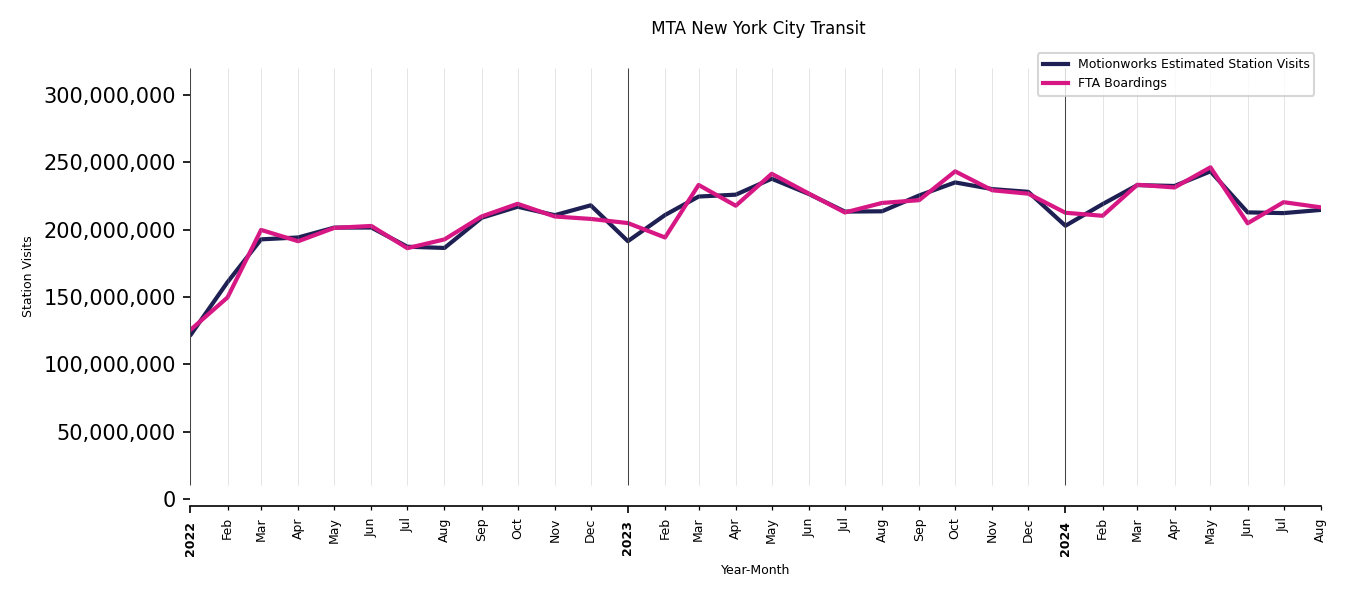
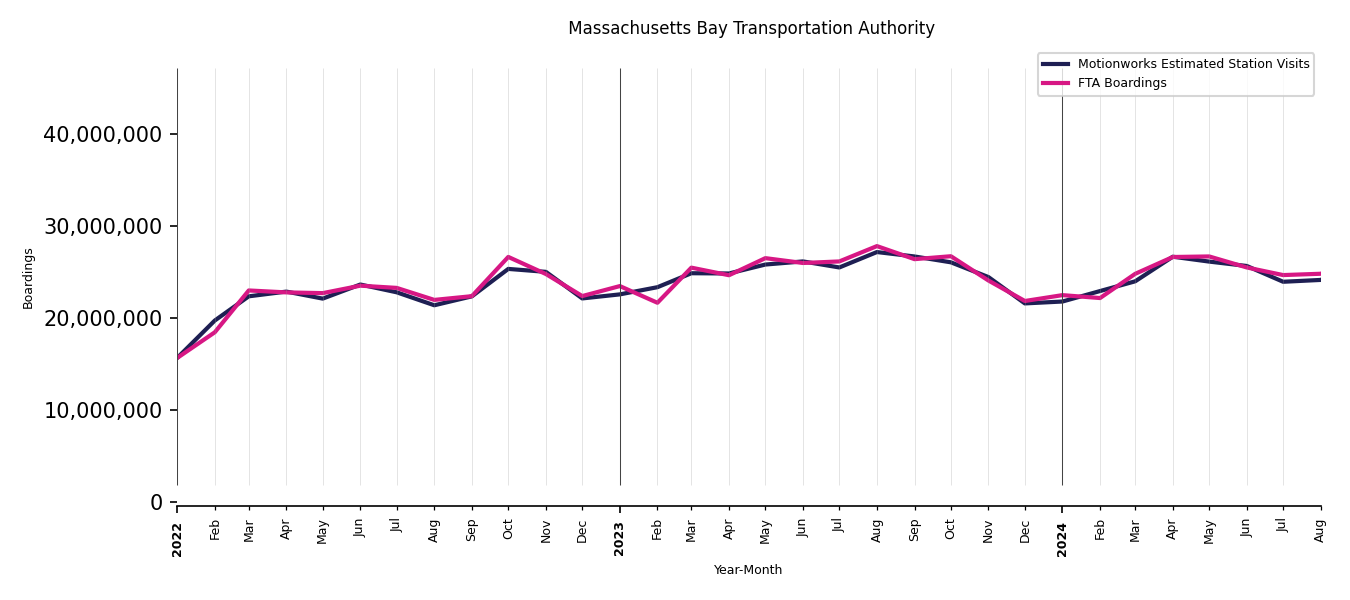
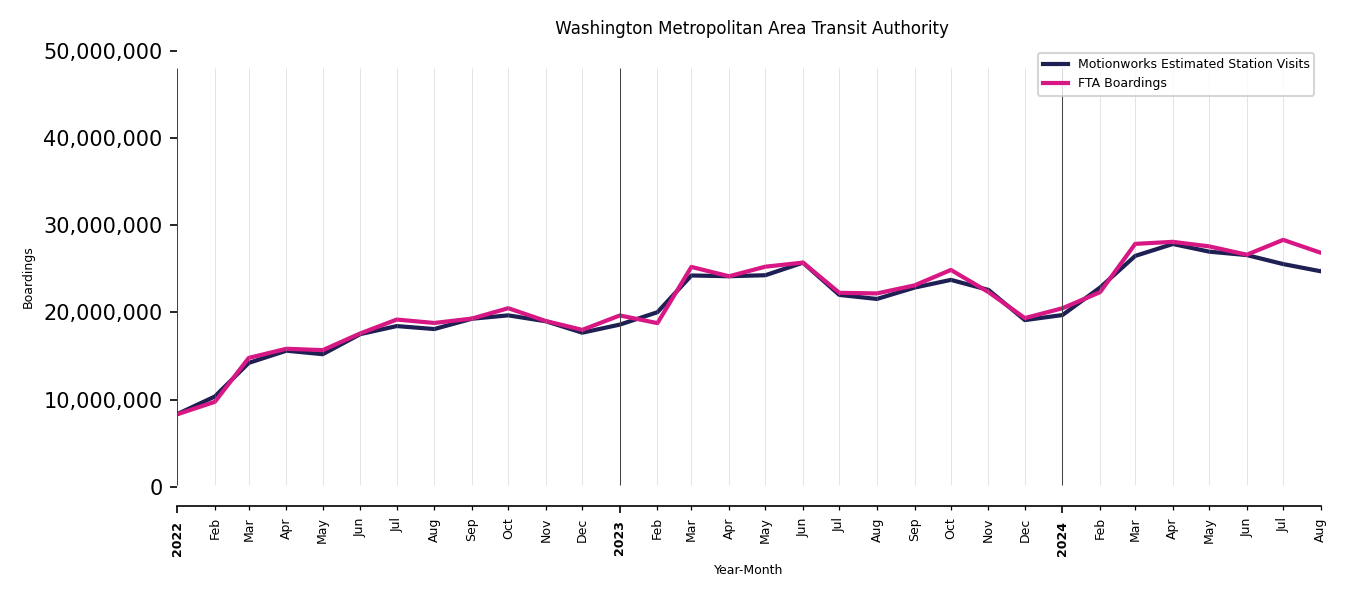
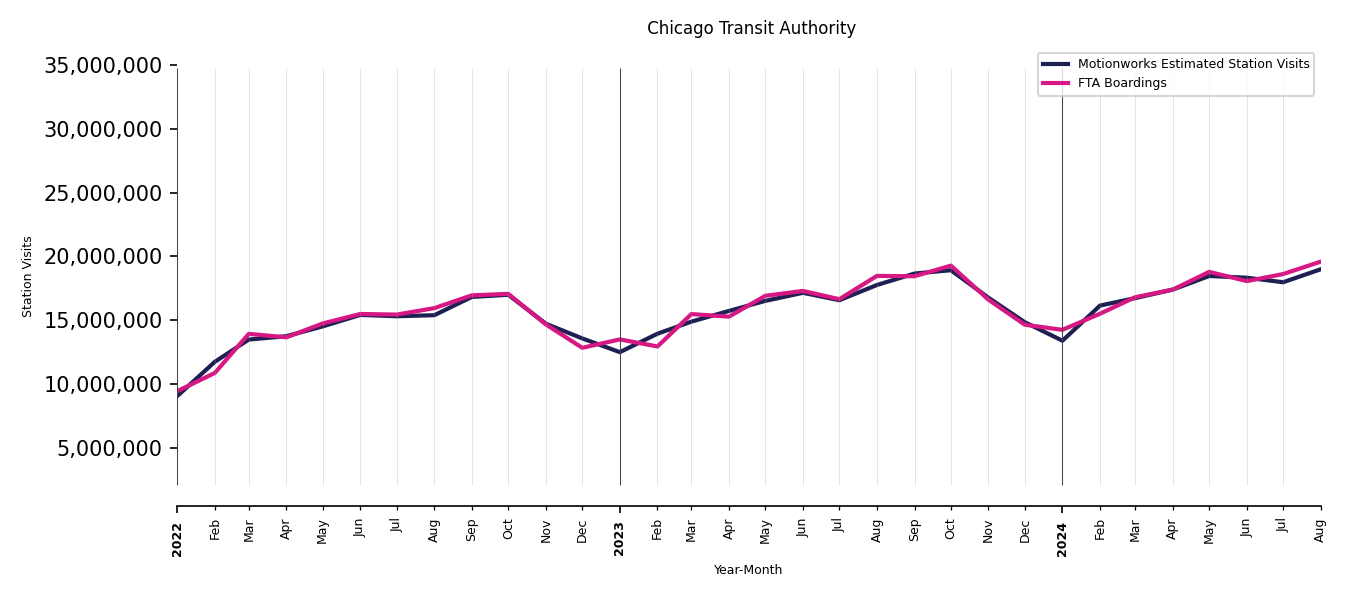
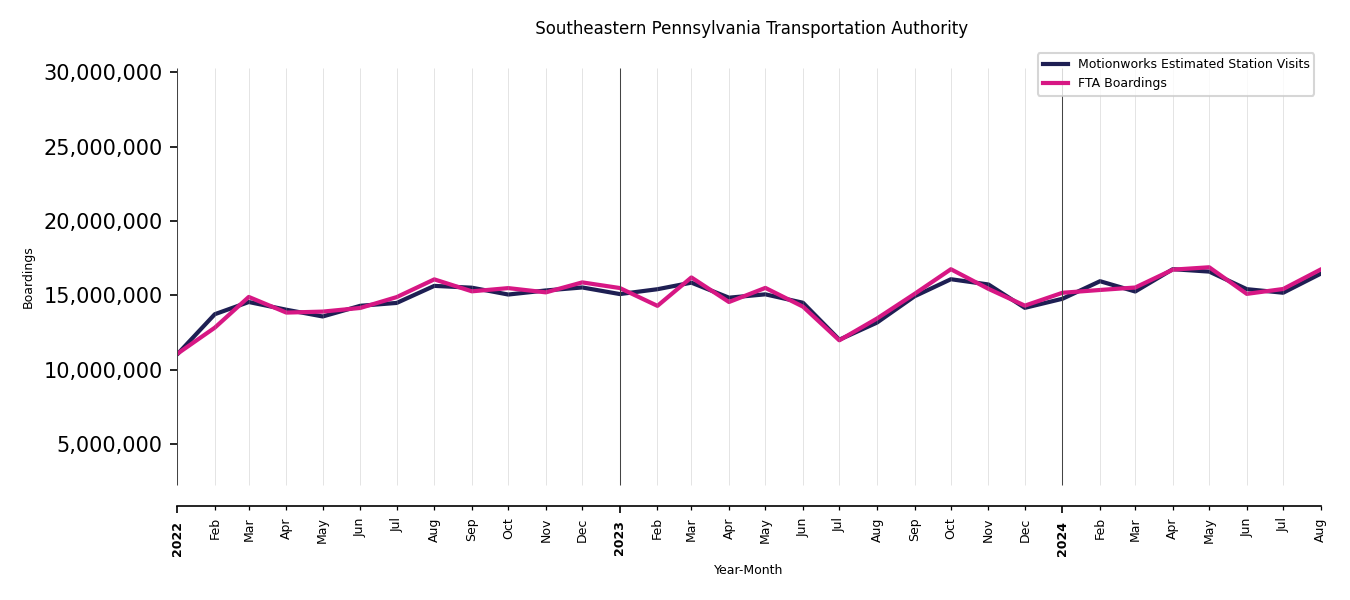
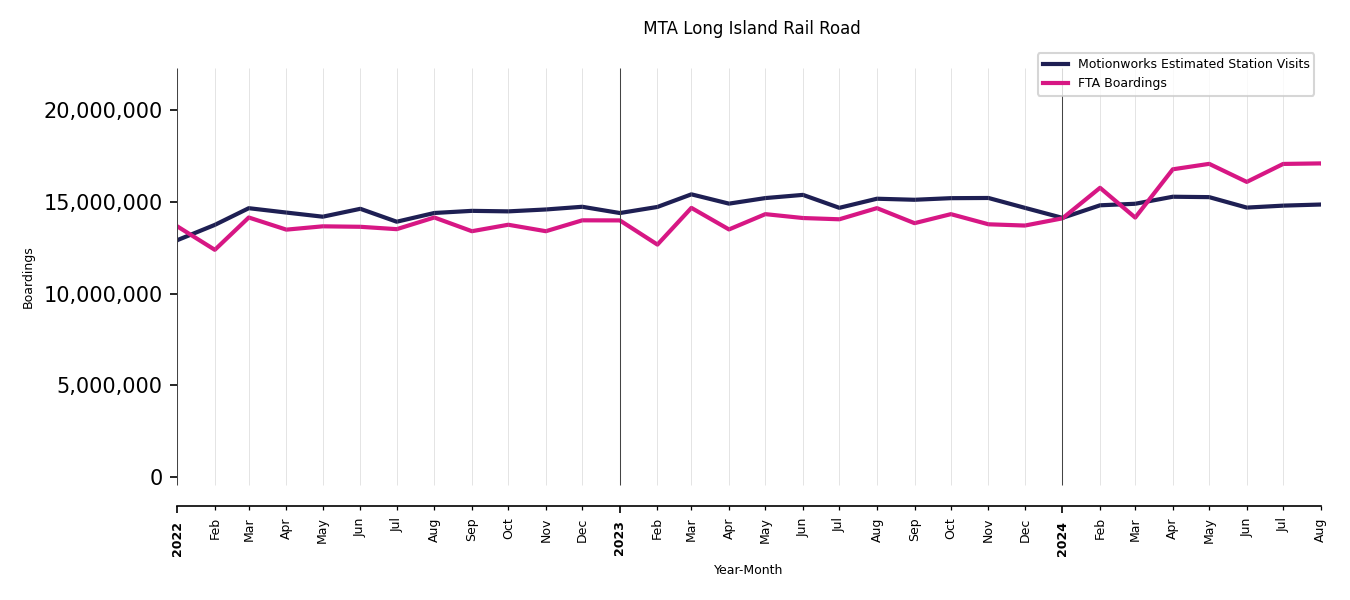
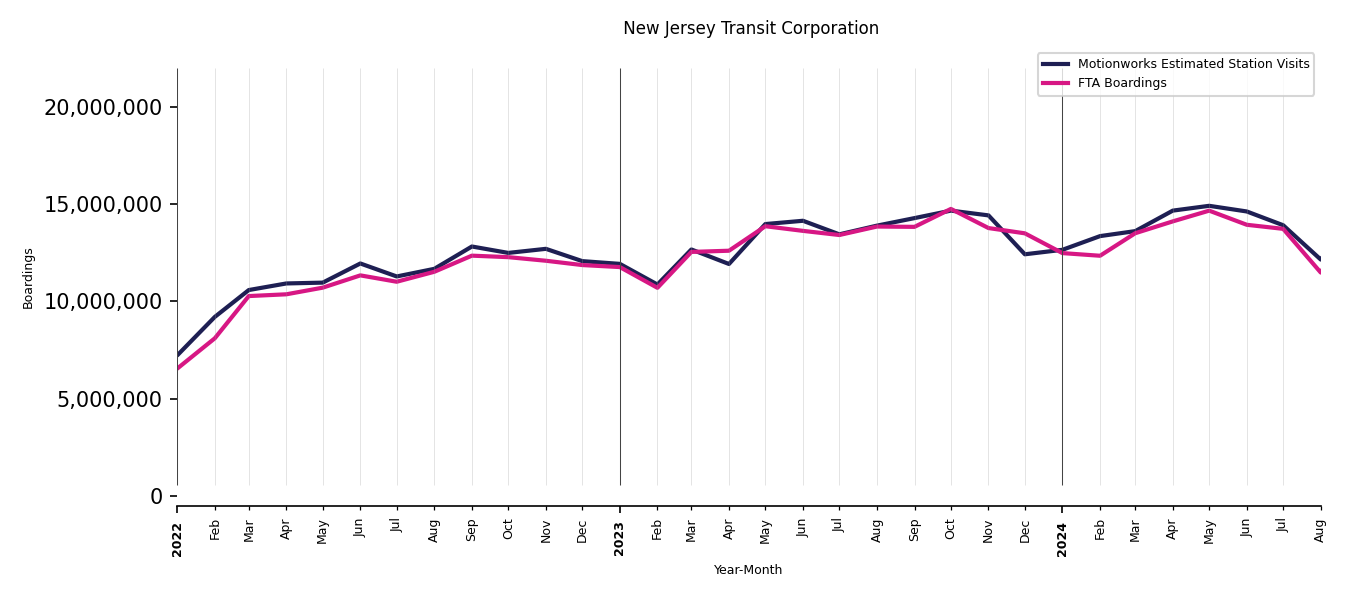
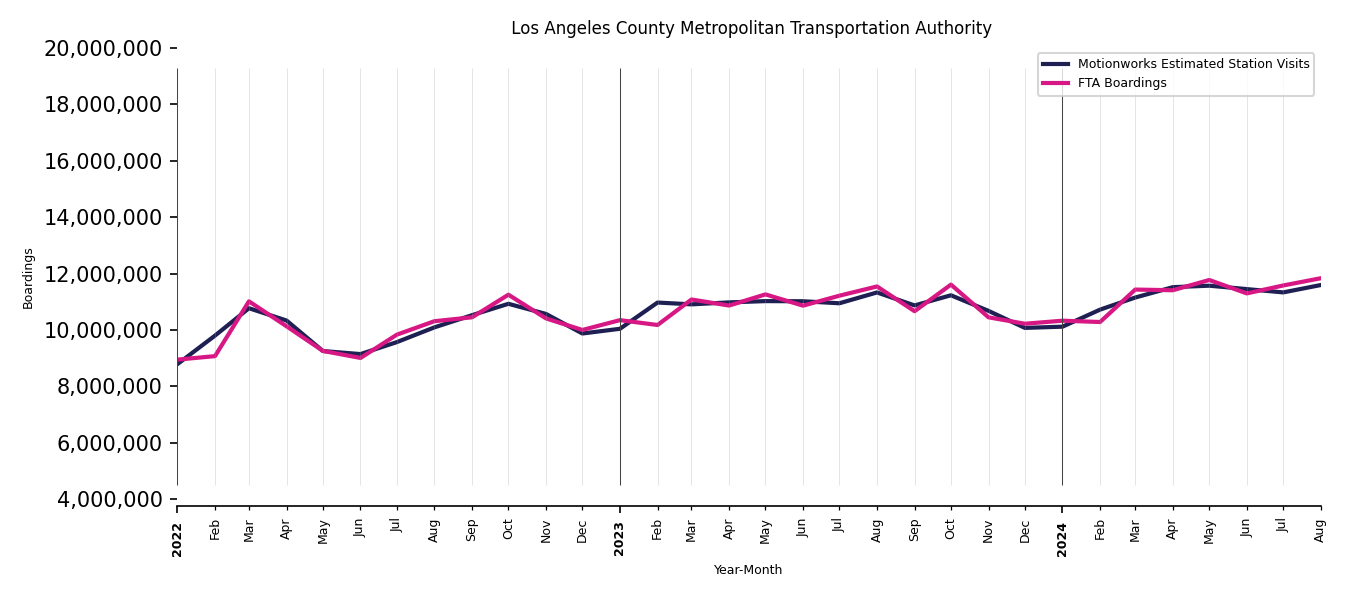
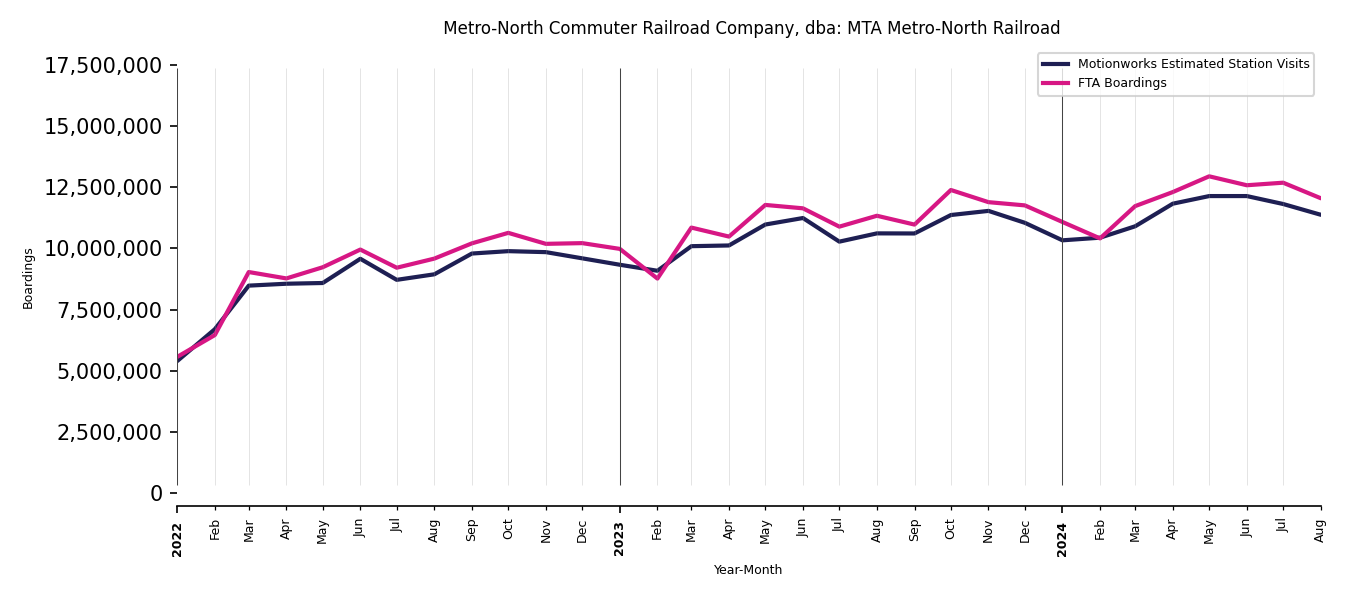
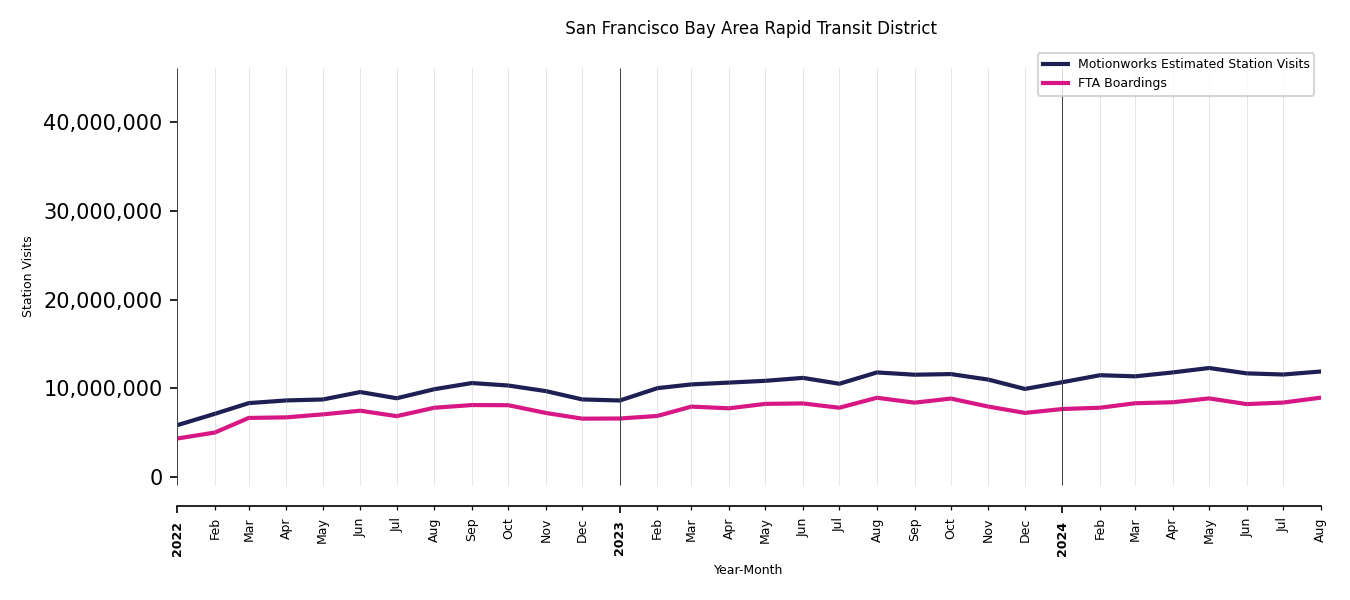
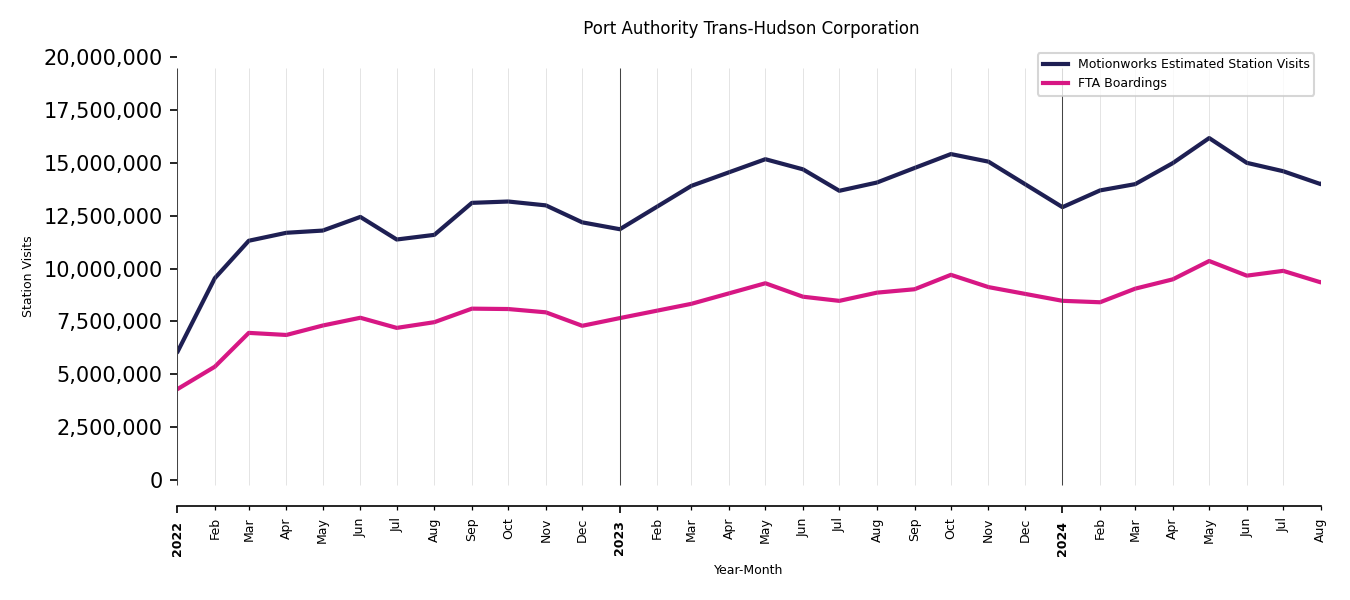
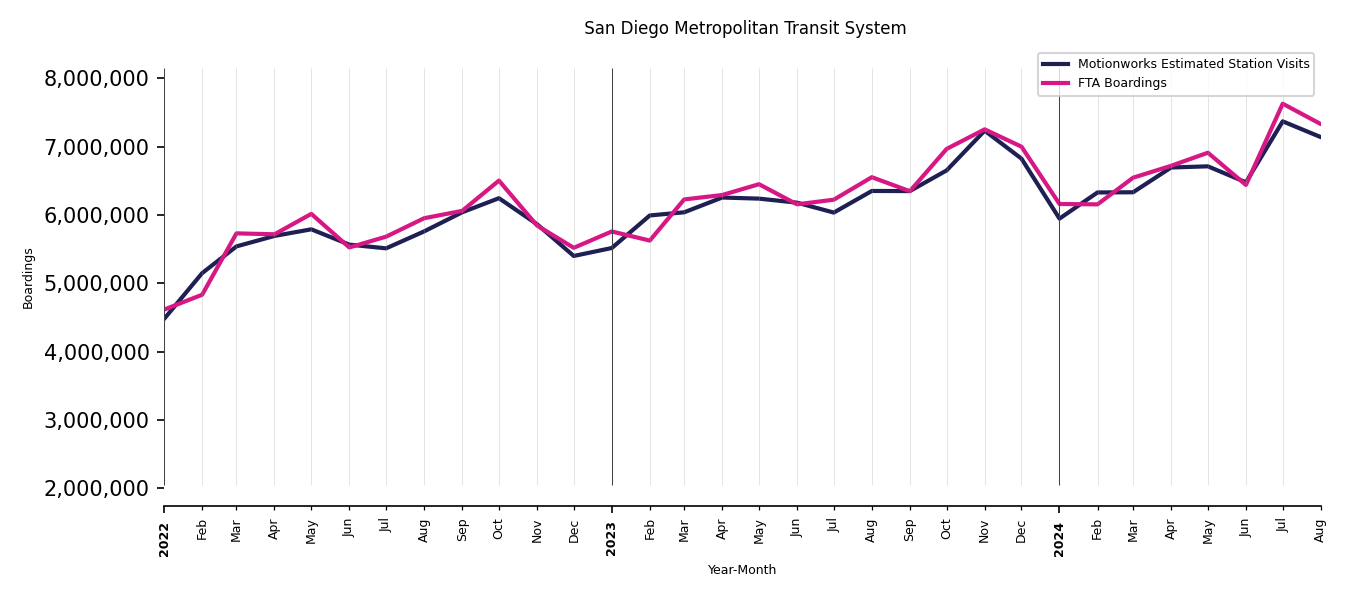
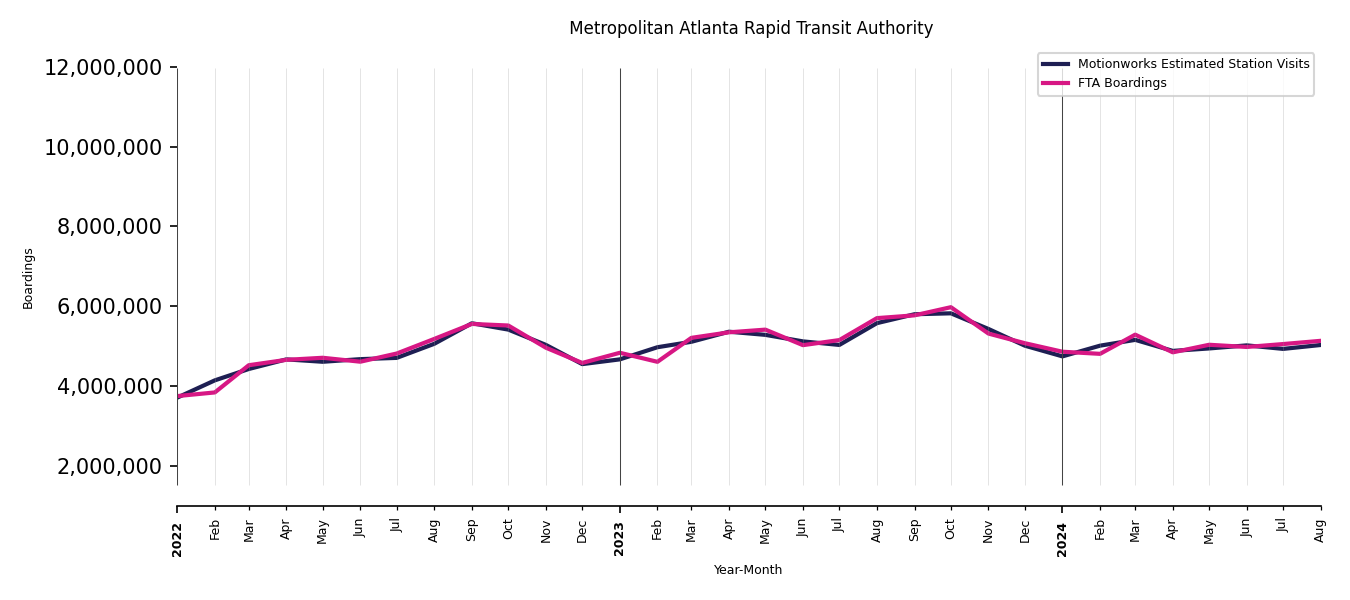
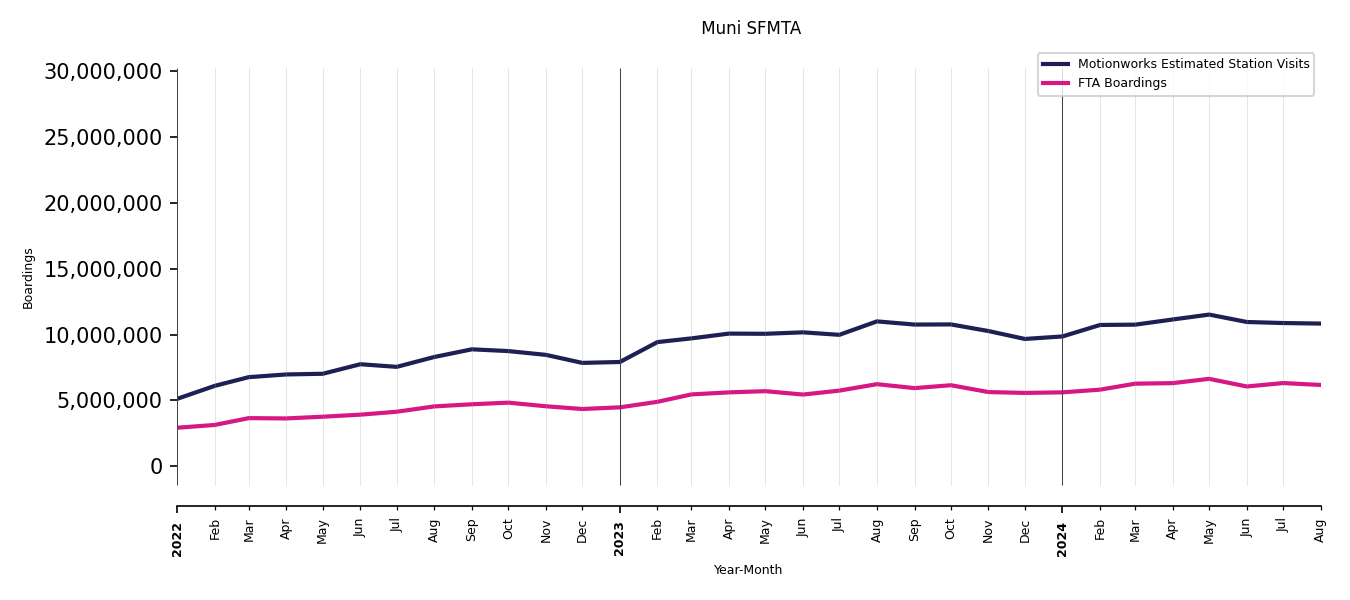
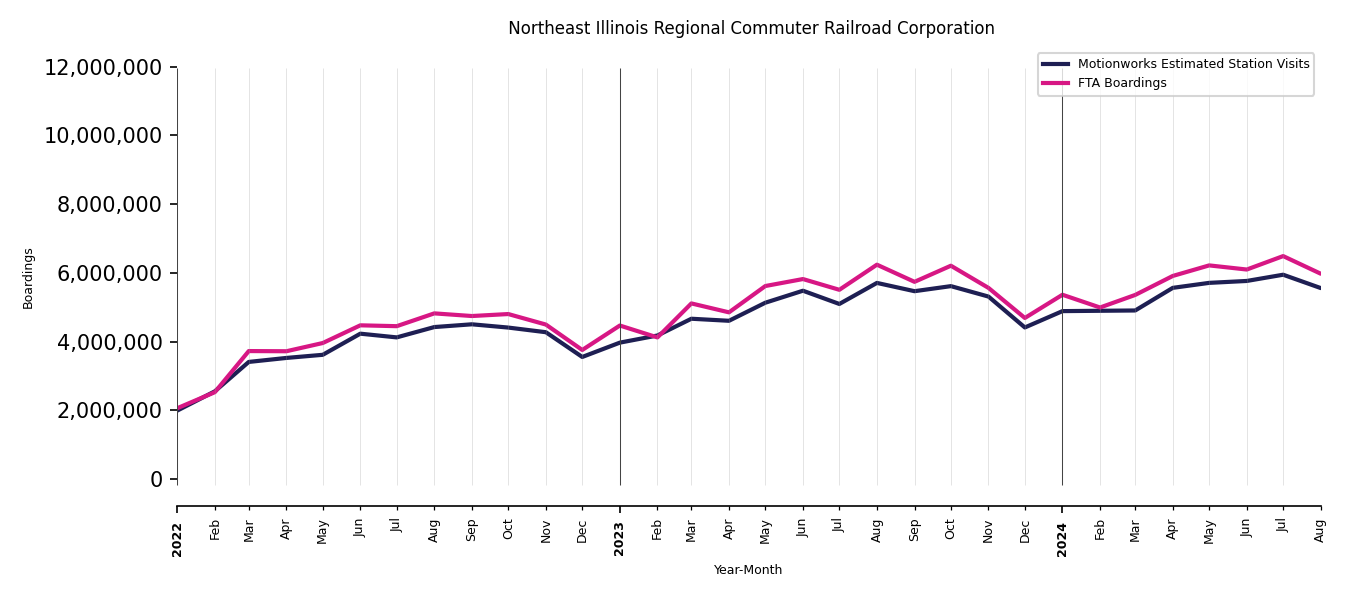
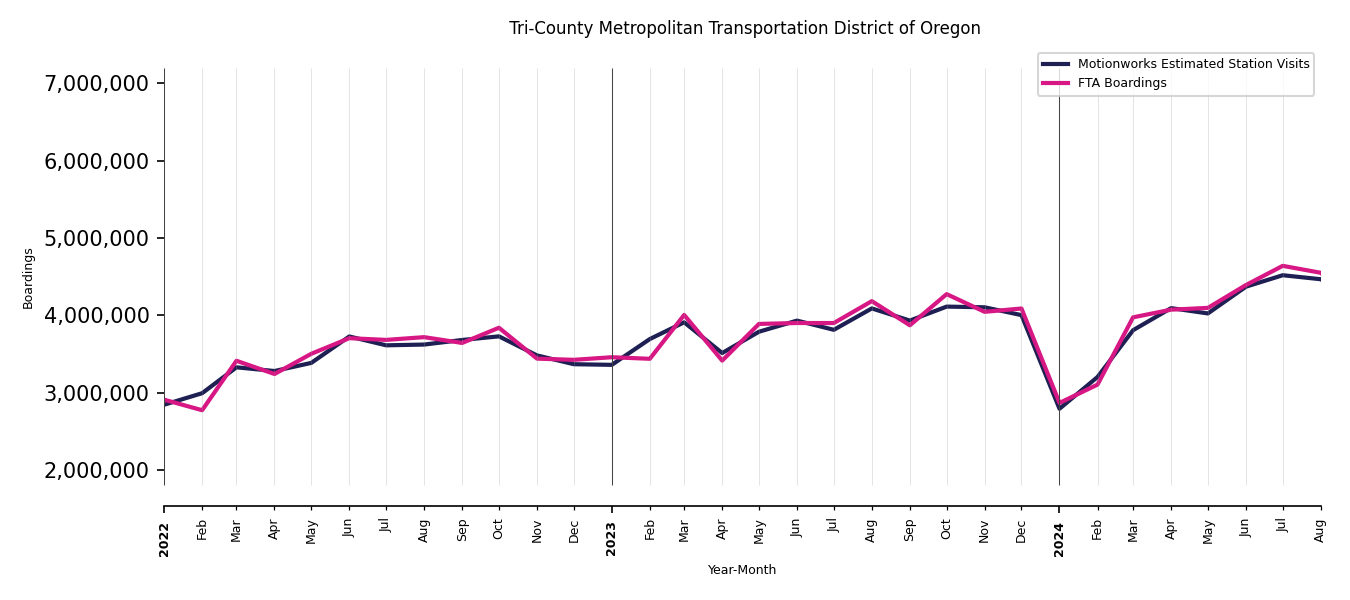
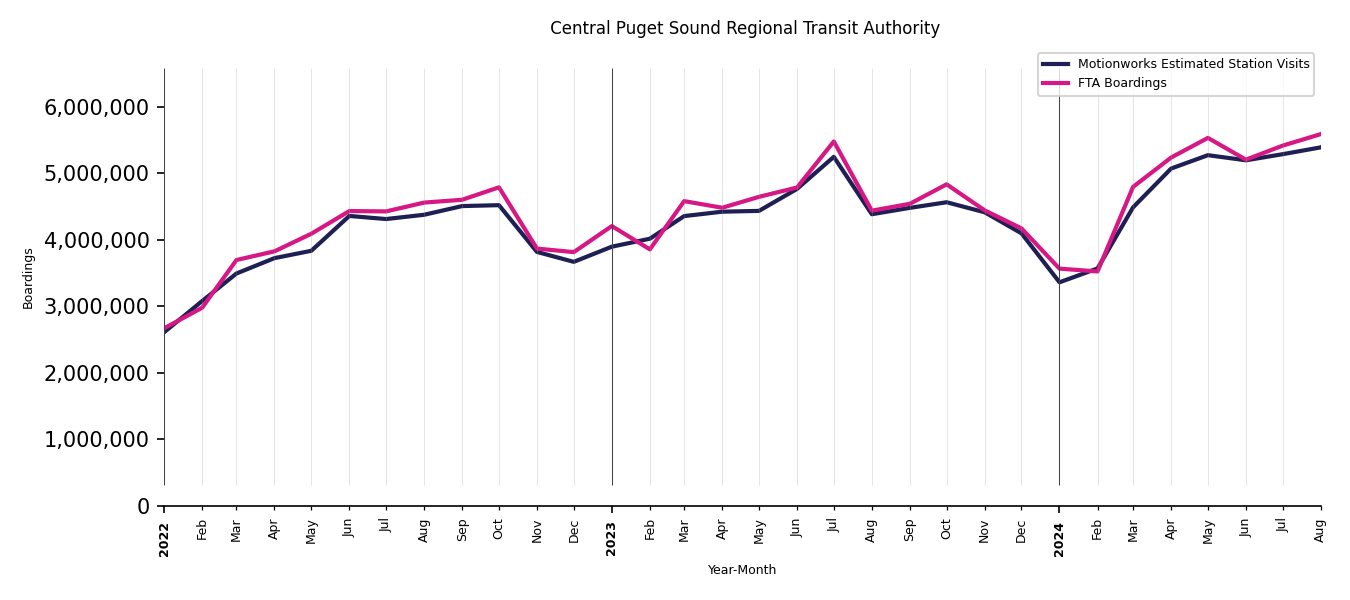
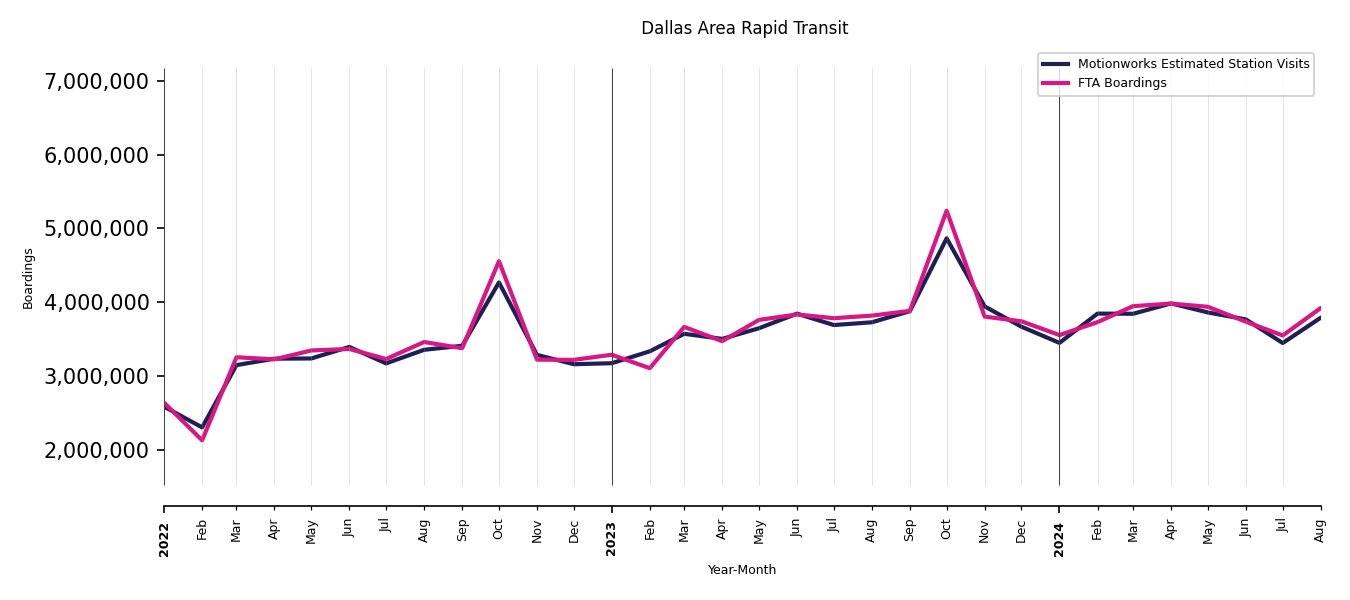
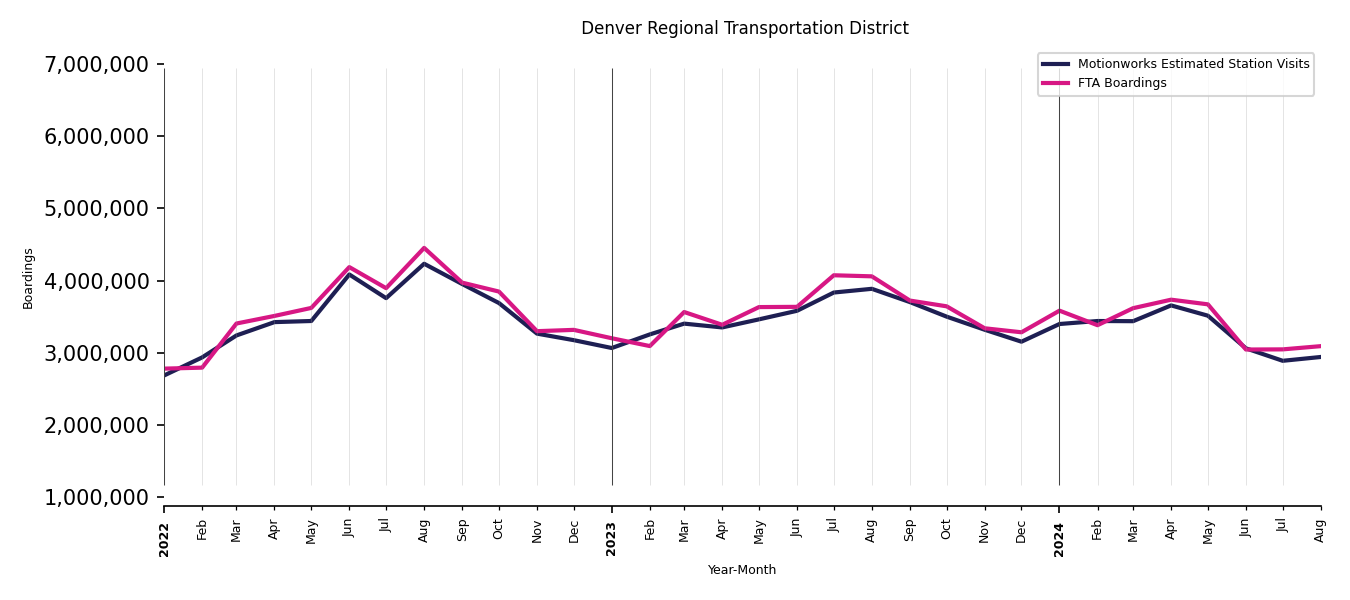
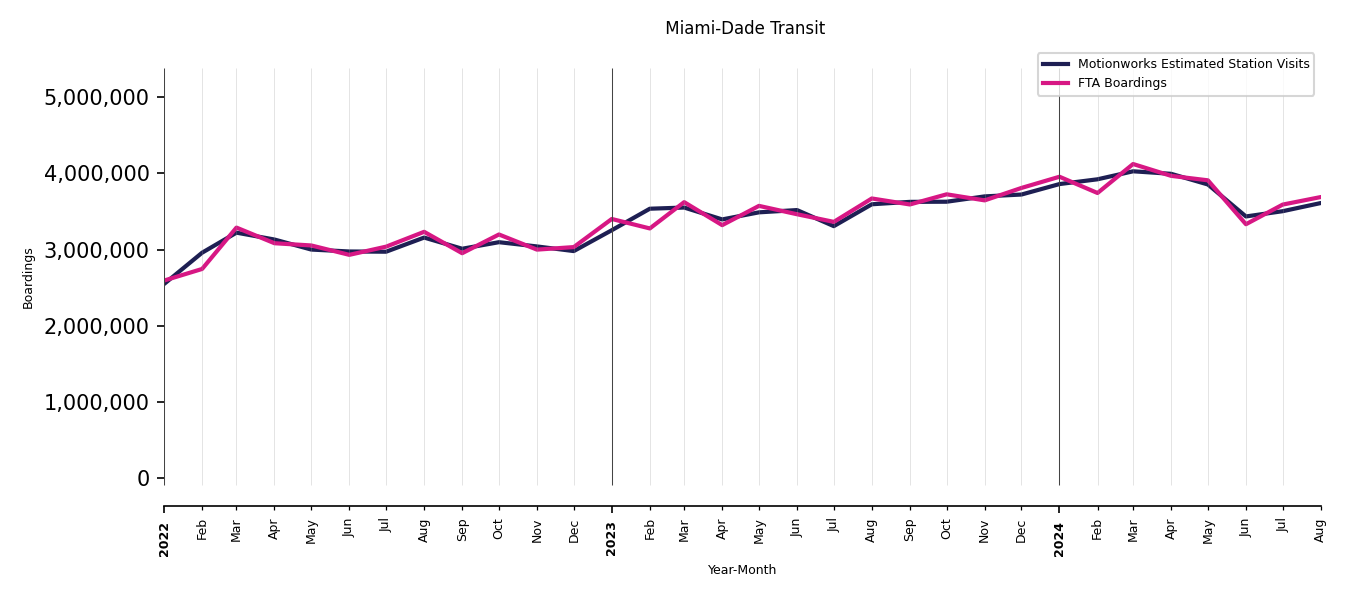
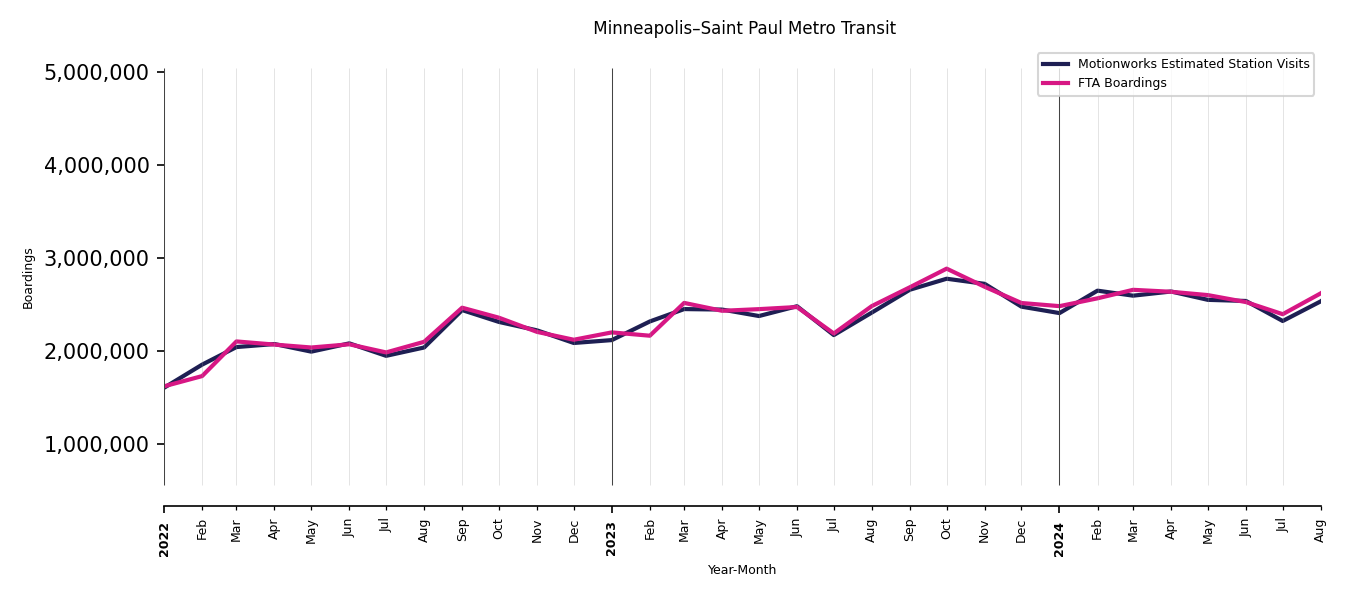
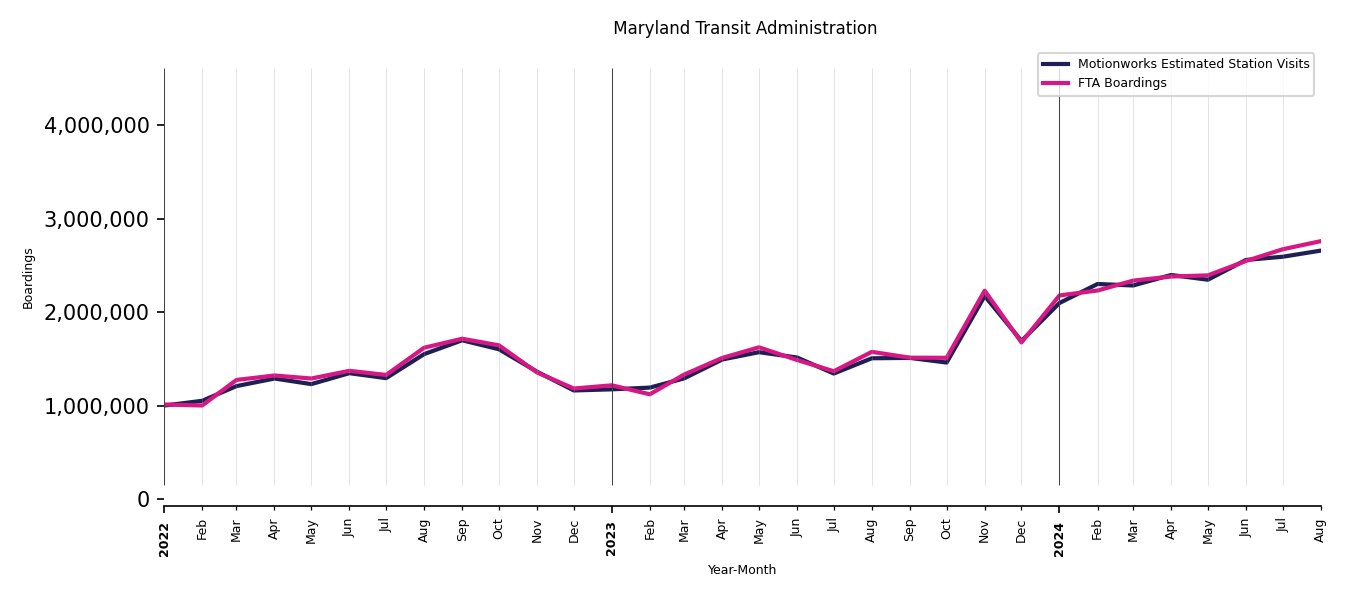
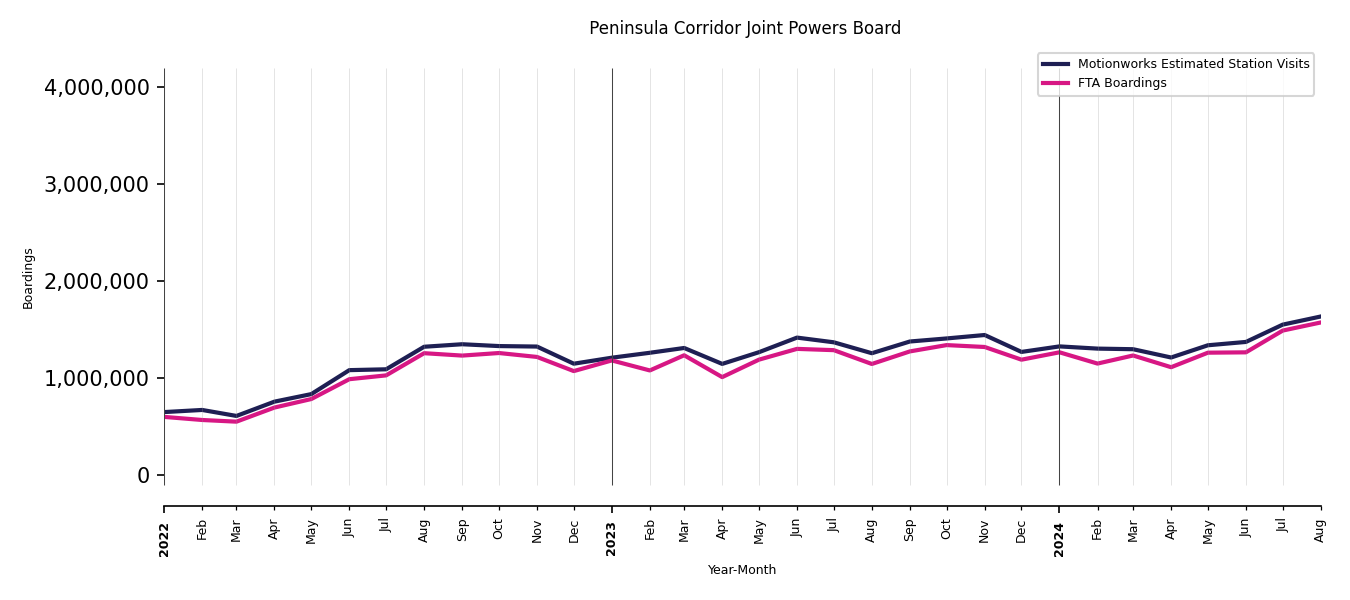
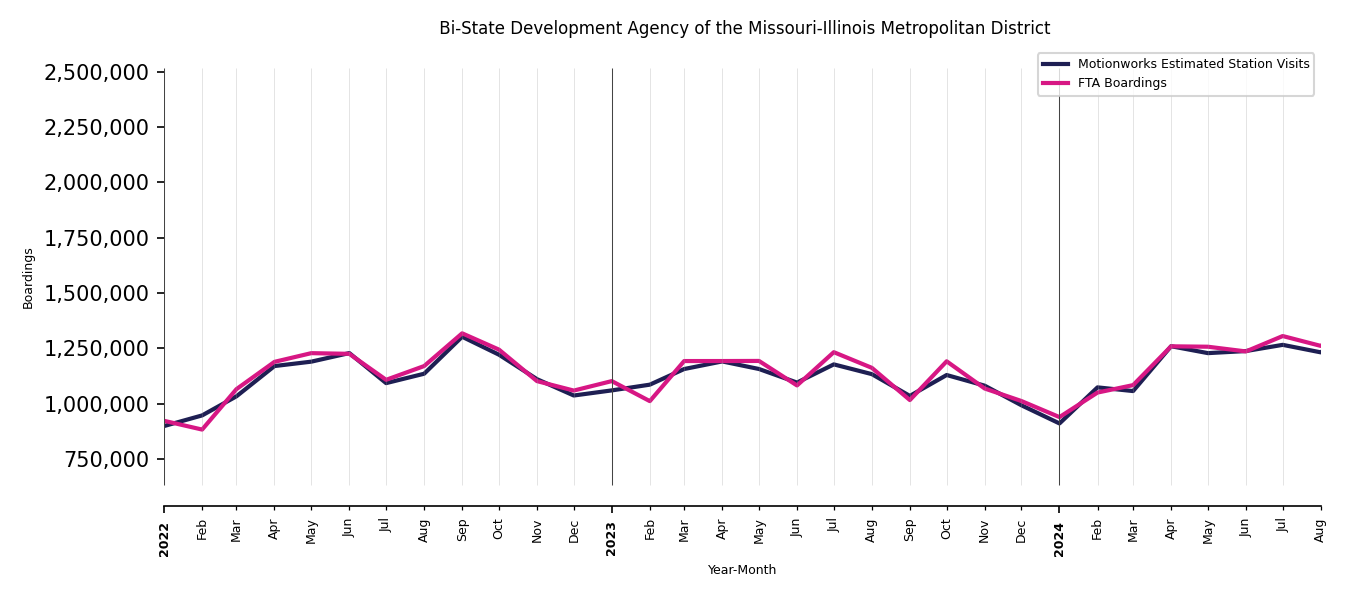
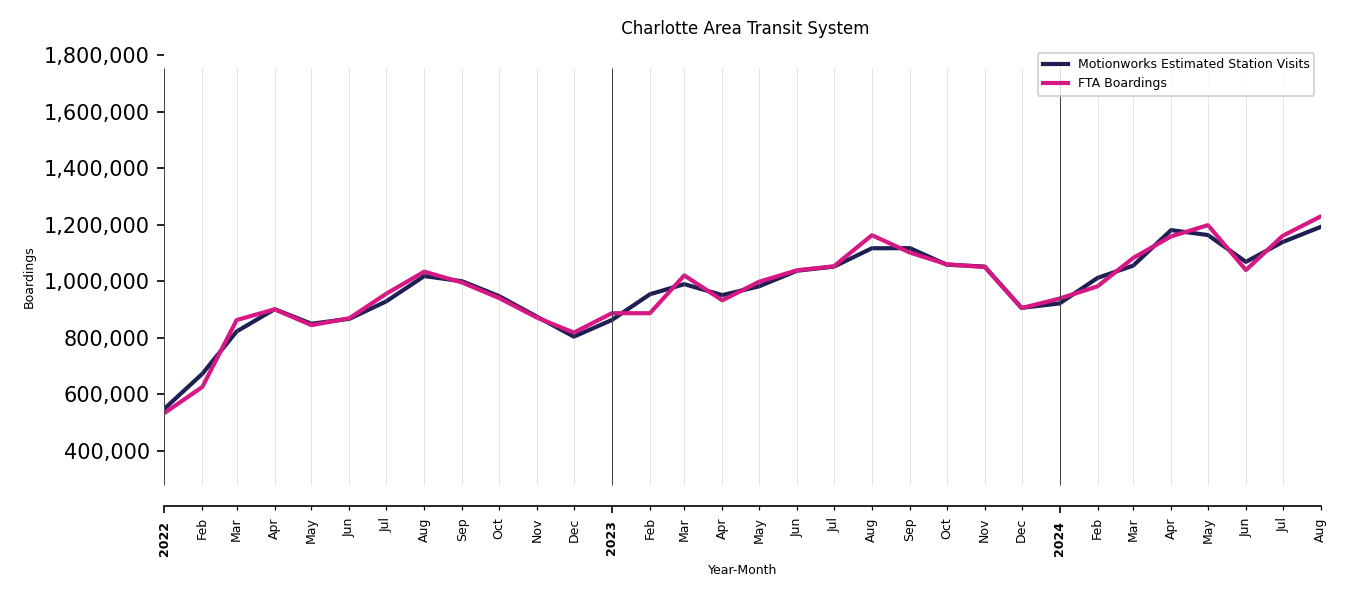
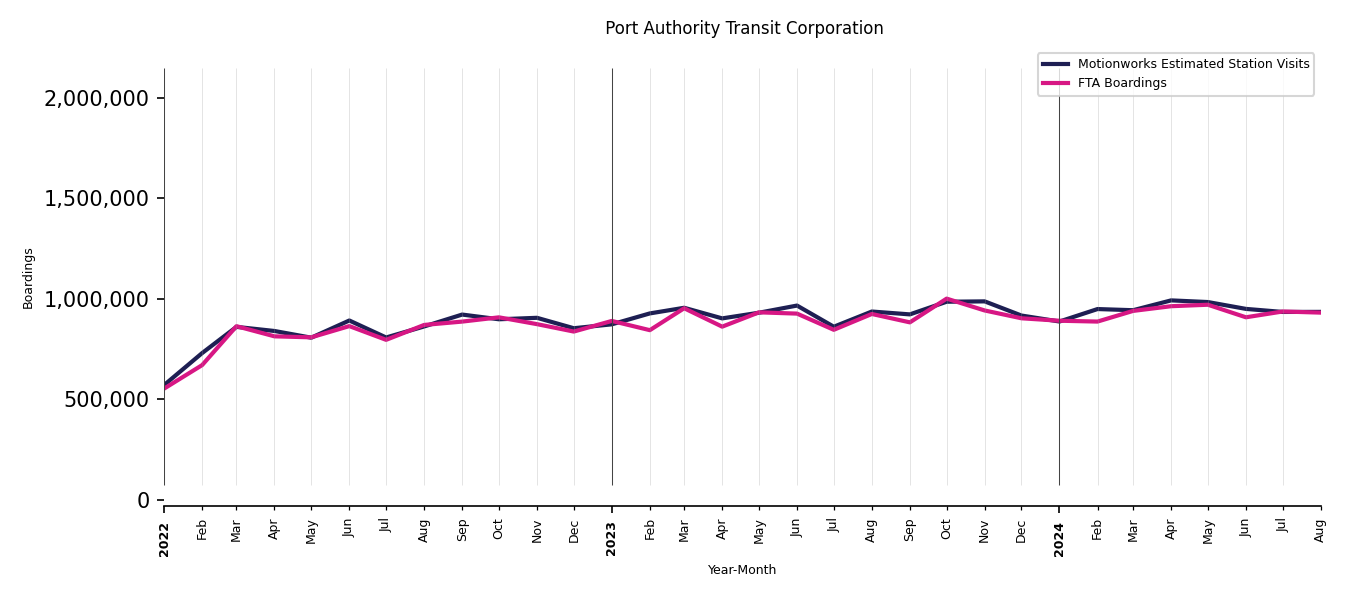
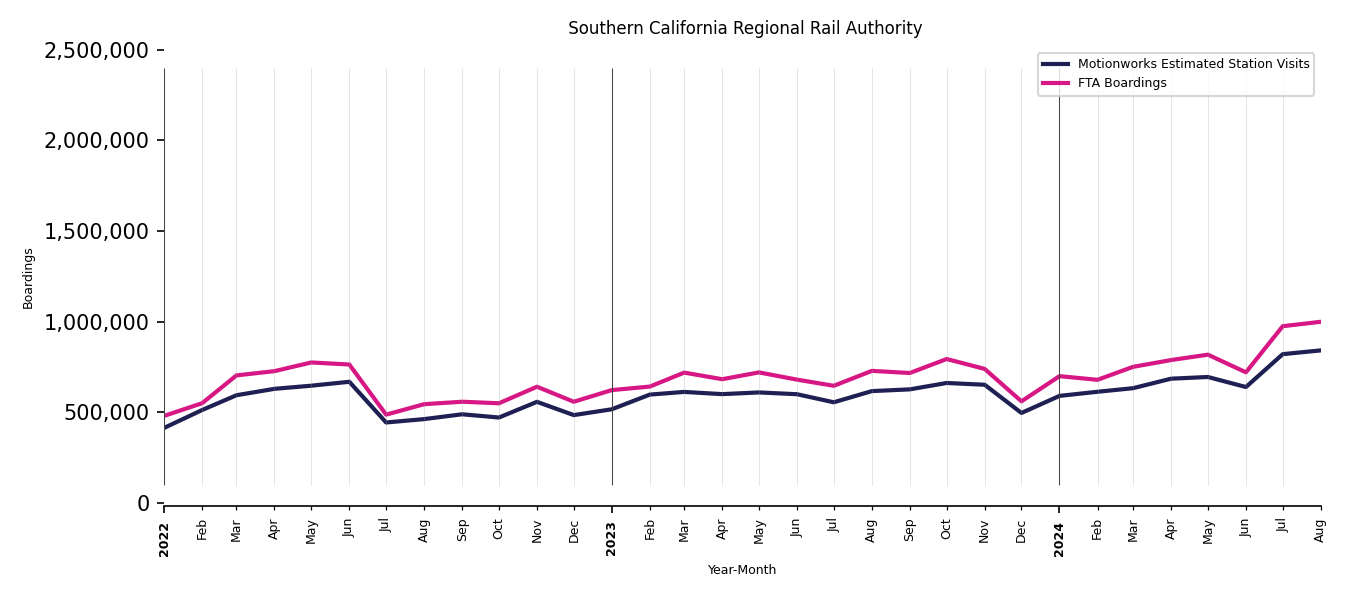
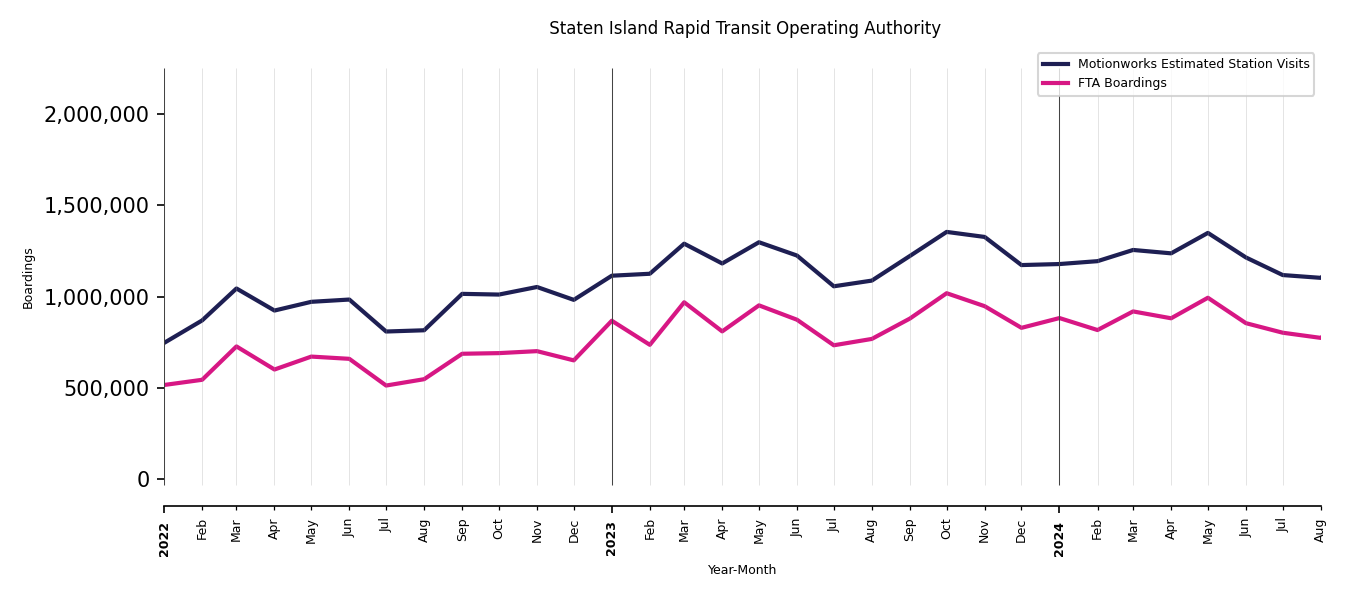
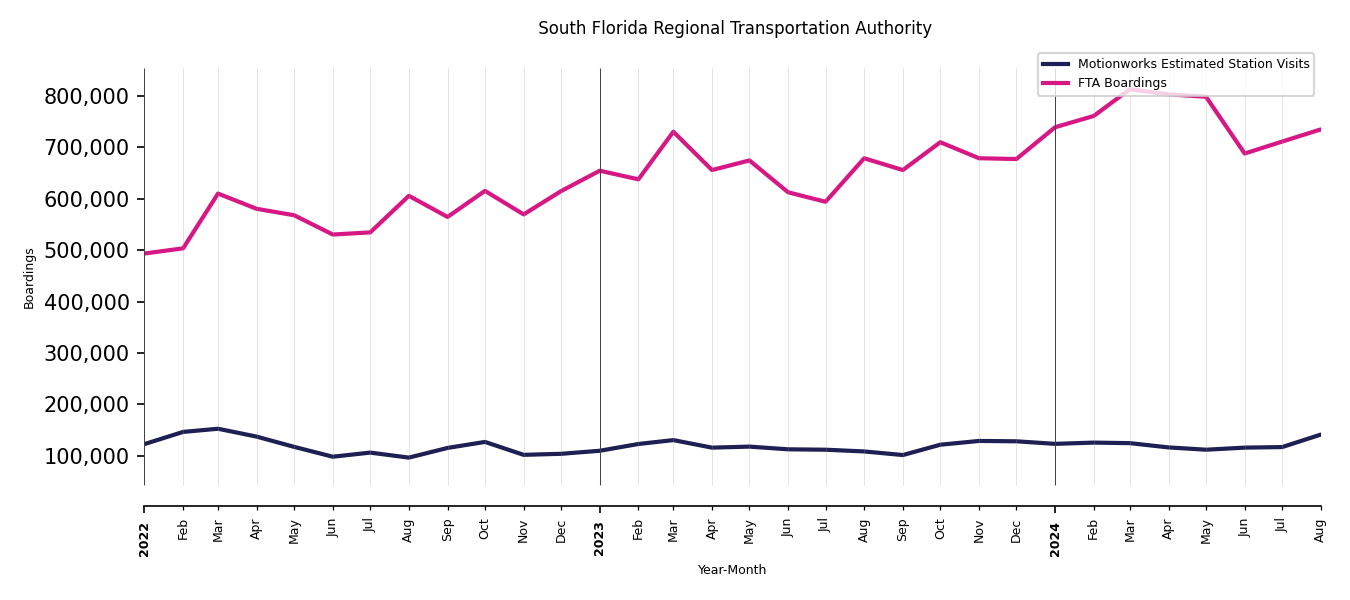
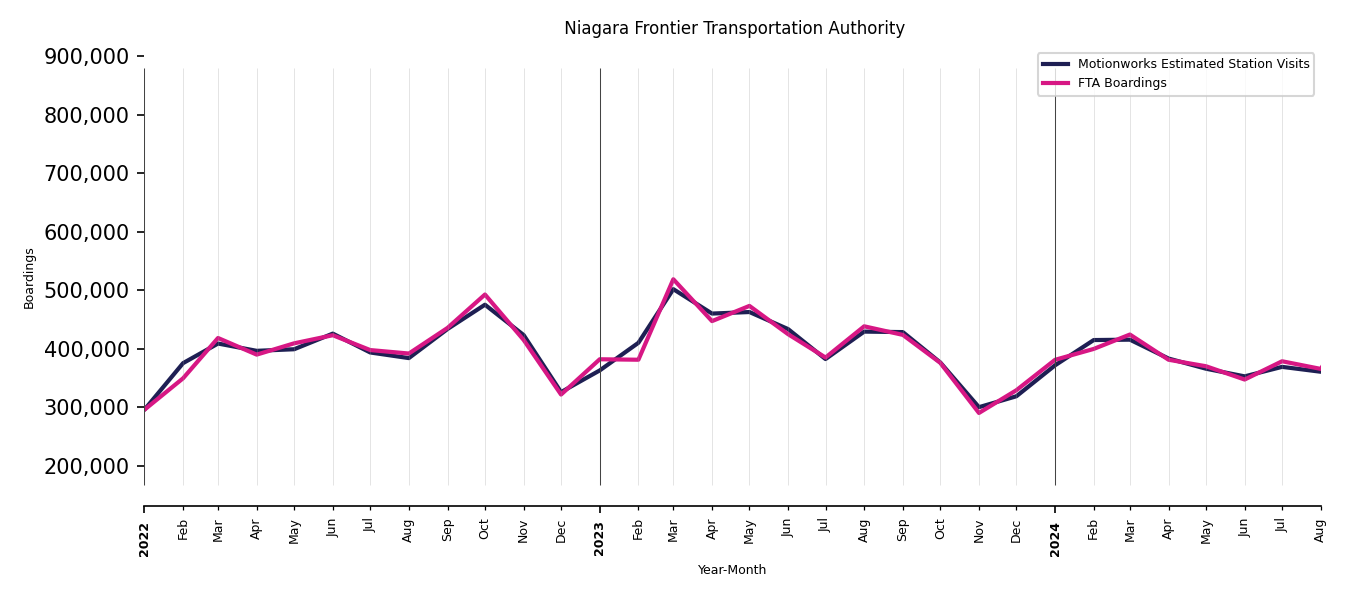
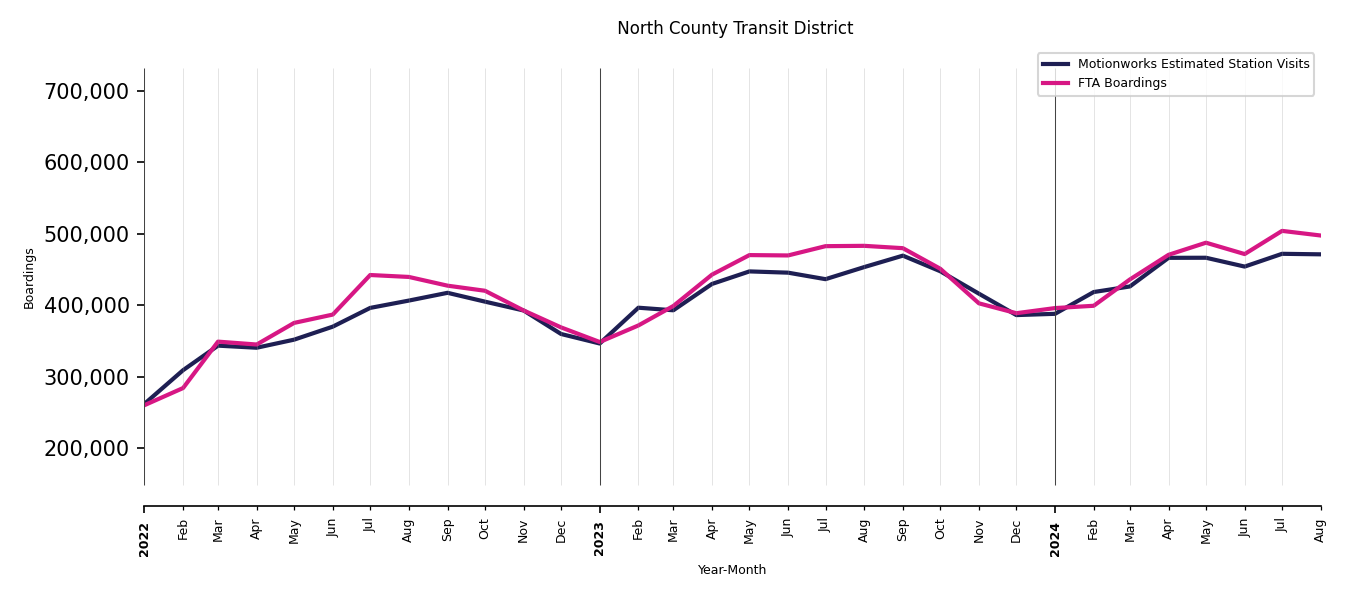
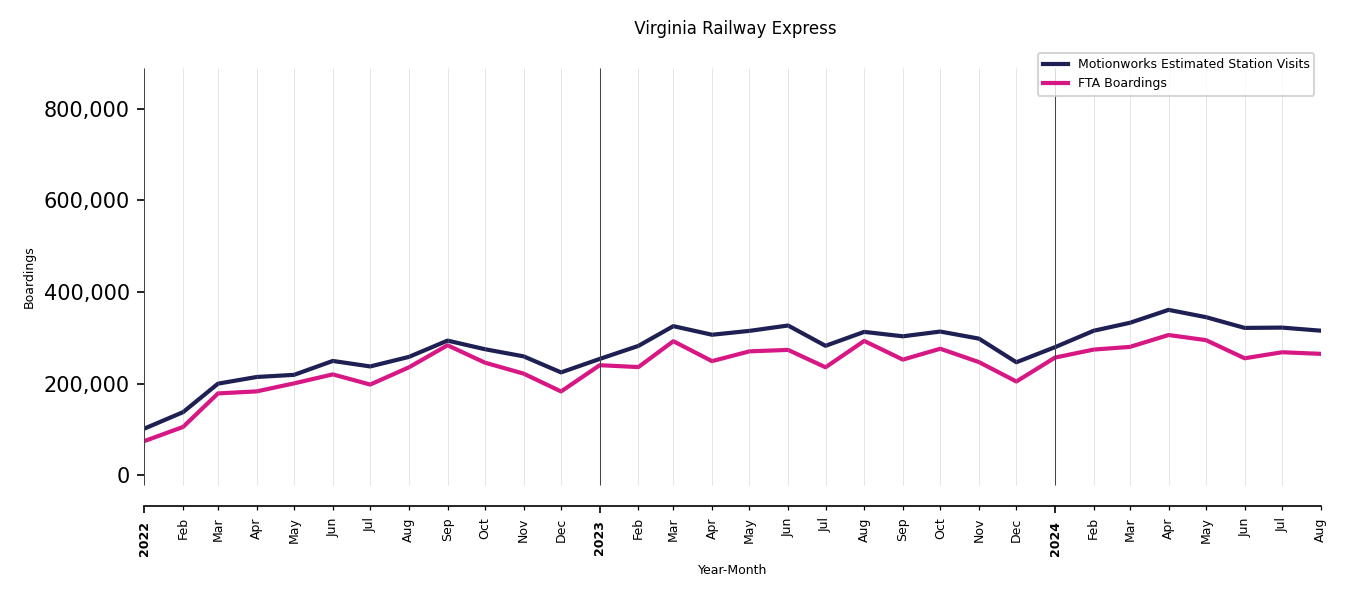

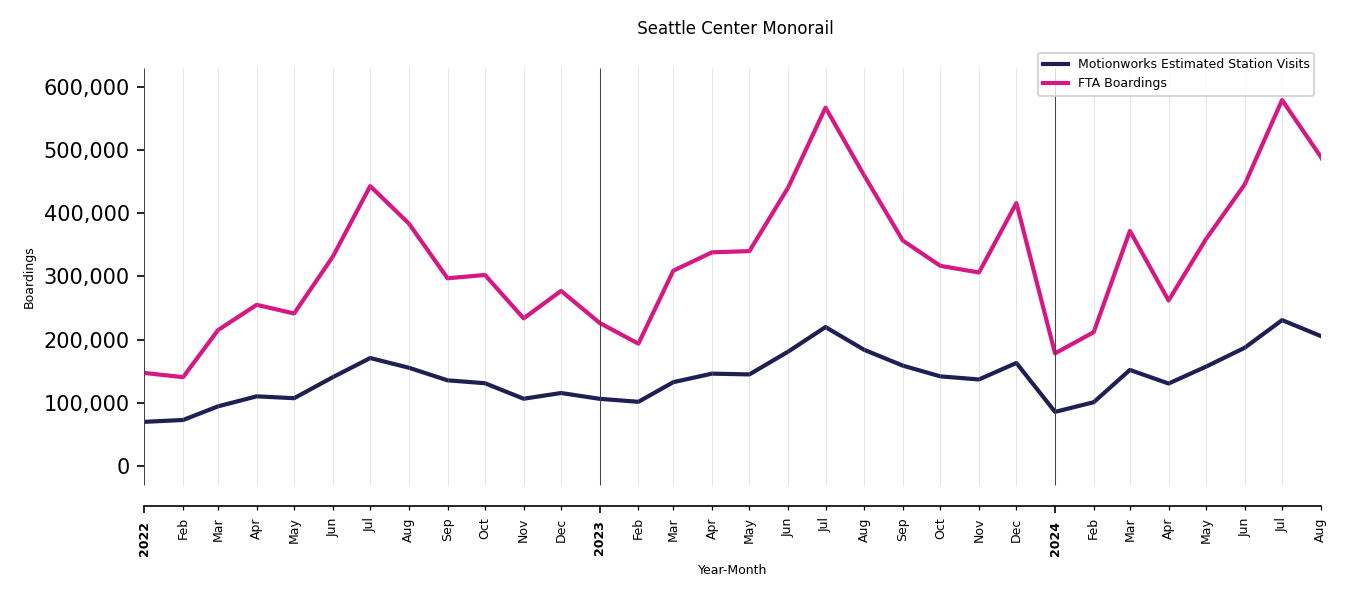
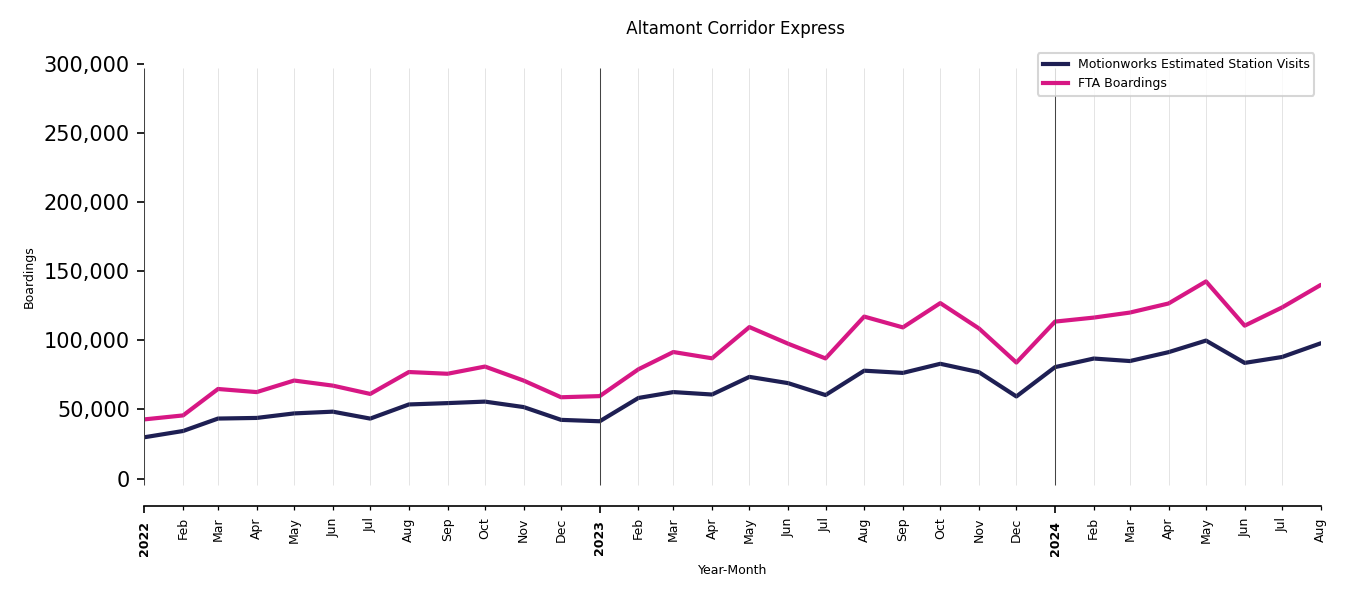
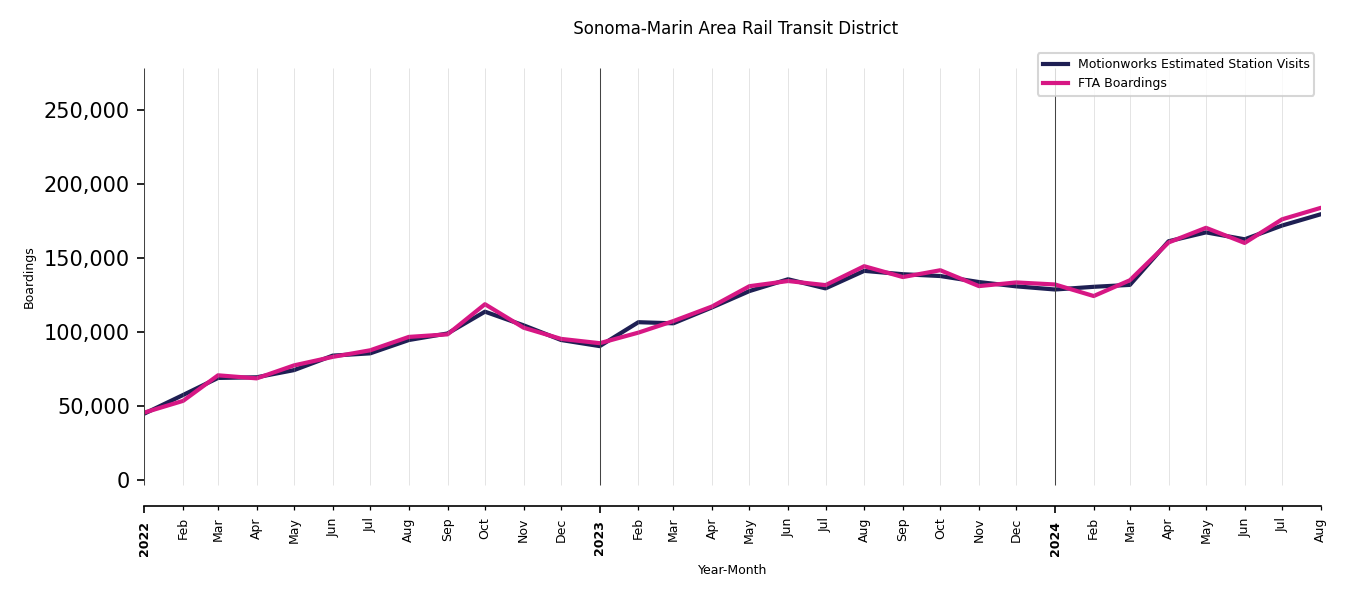
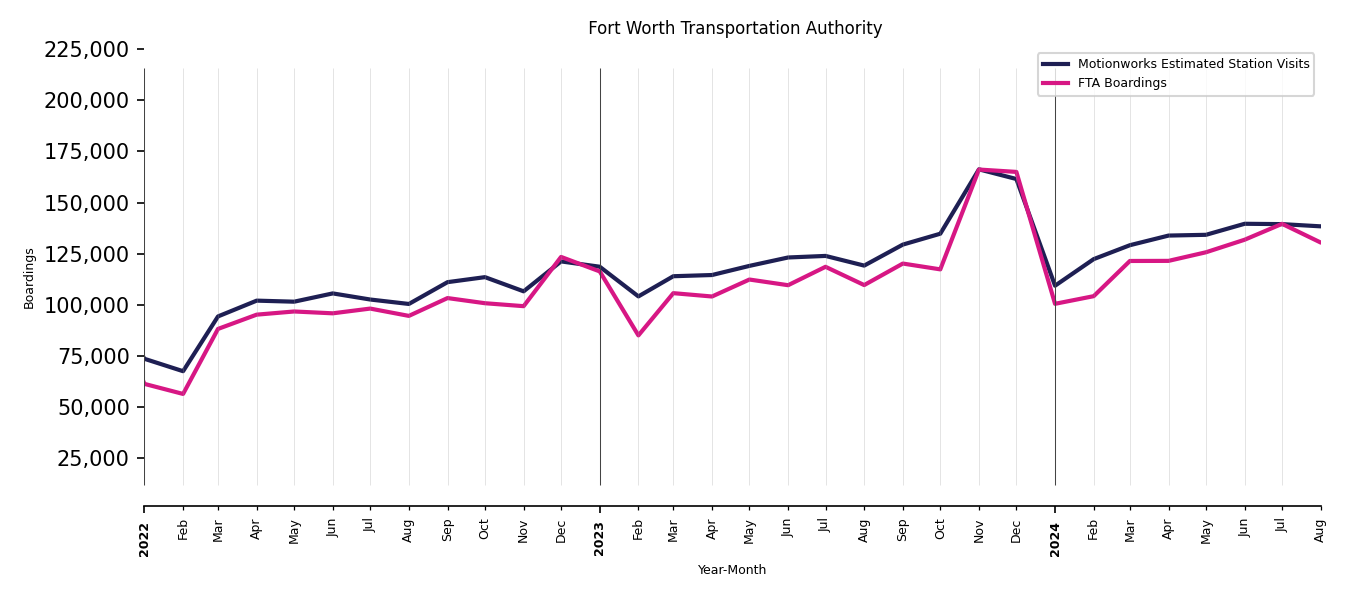
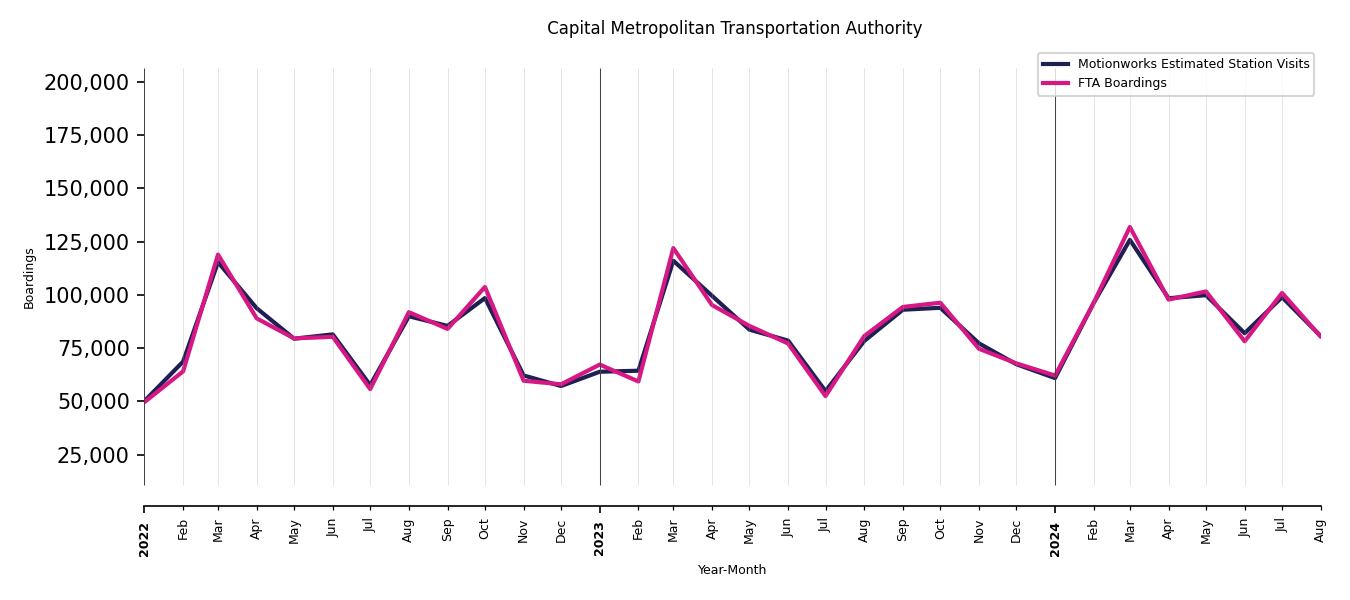
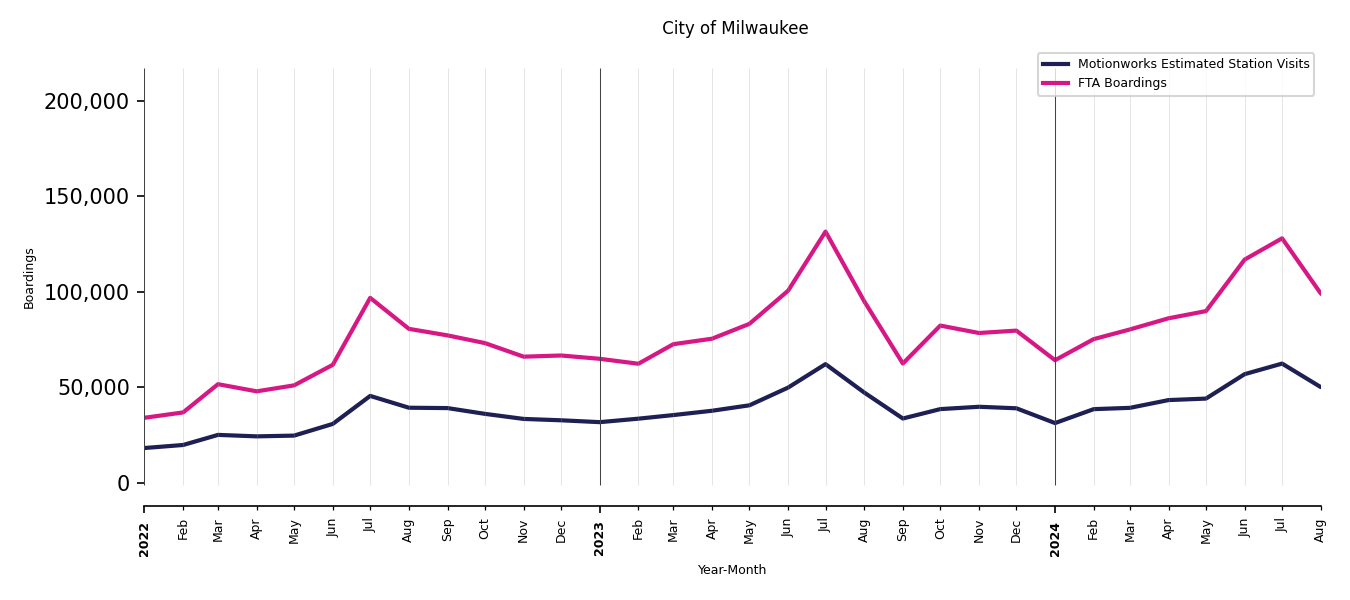
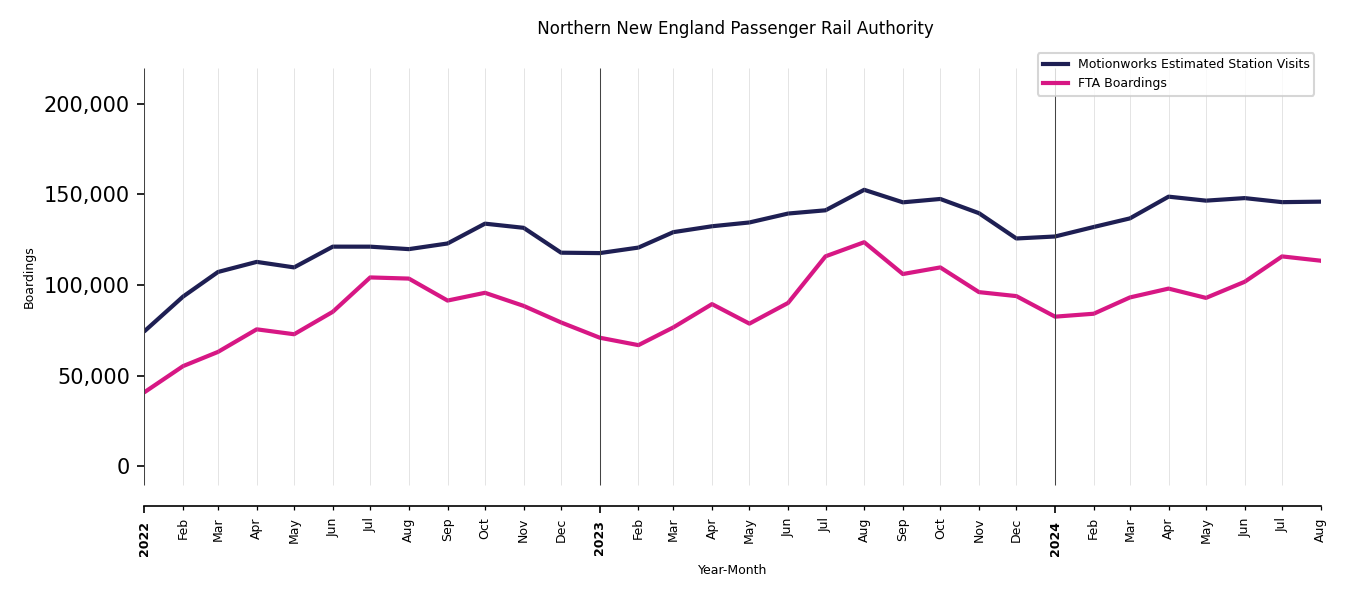
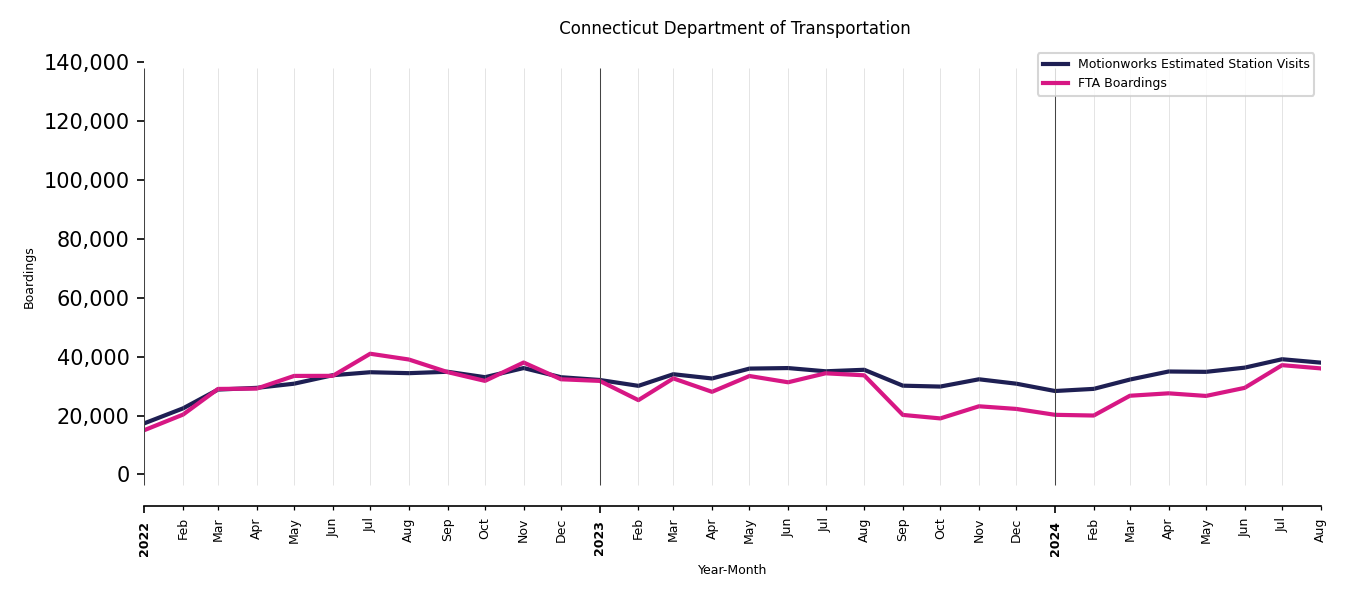
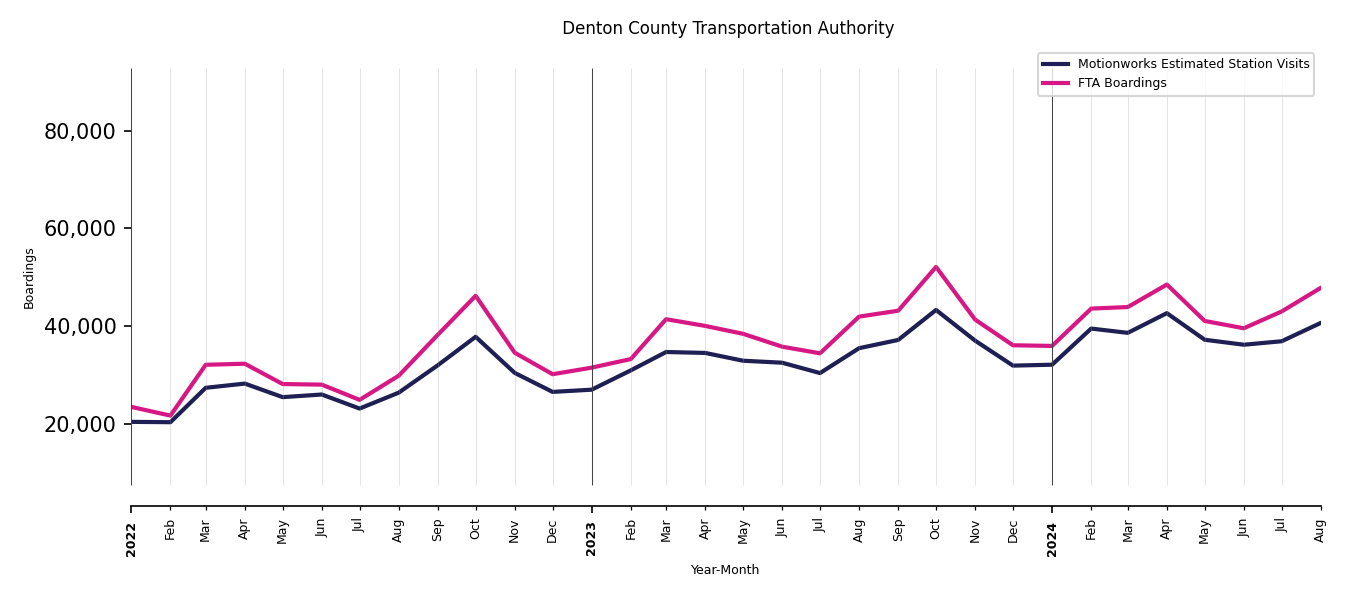
Updated about 2 months ago
